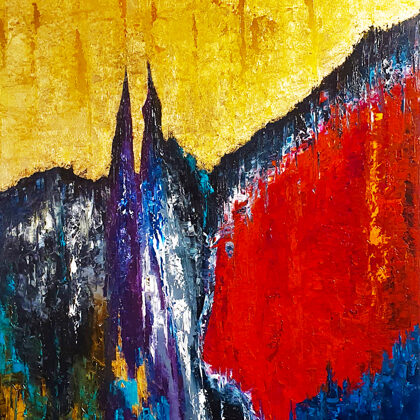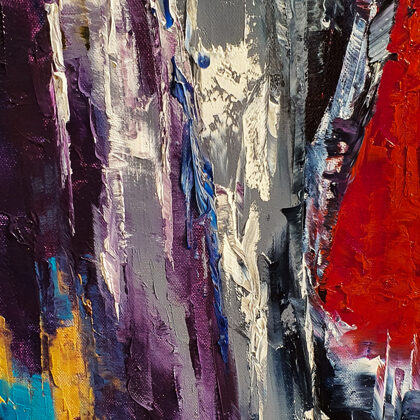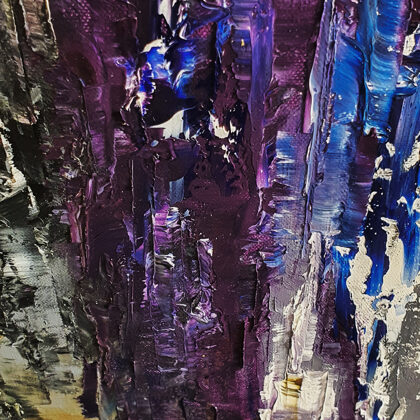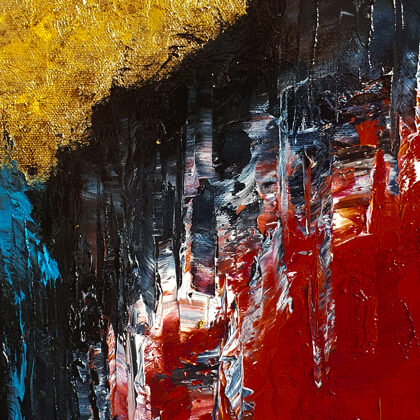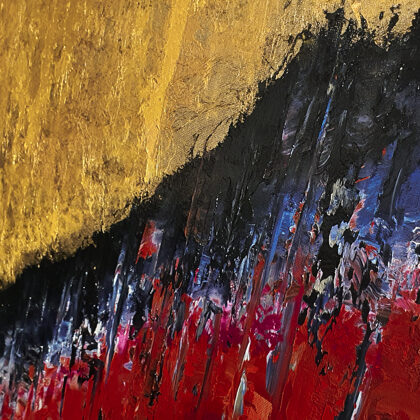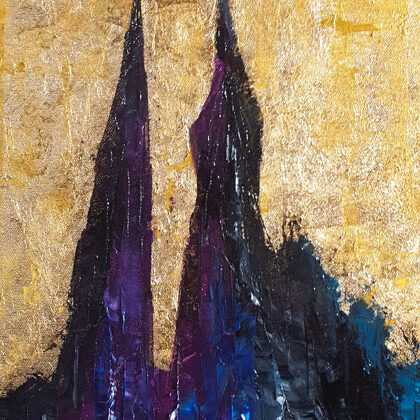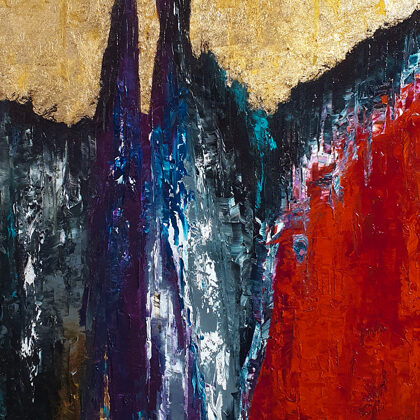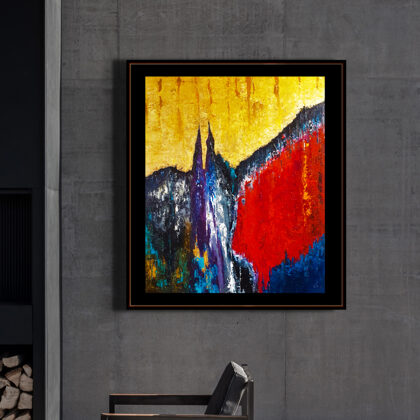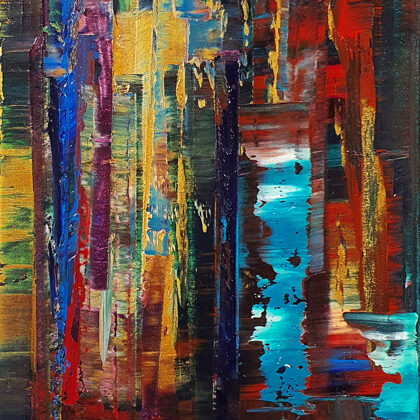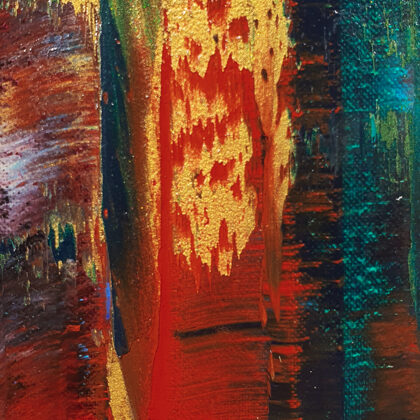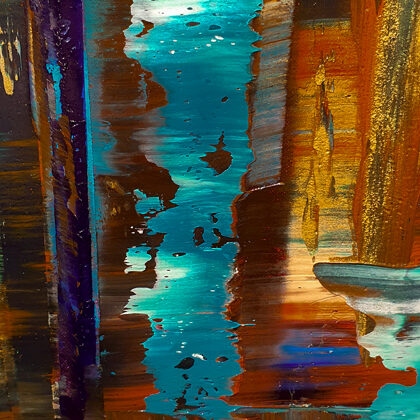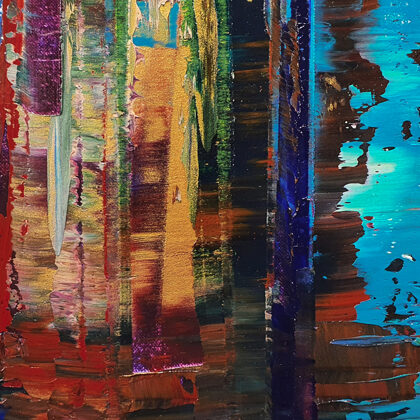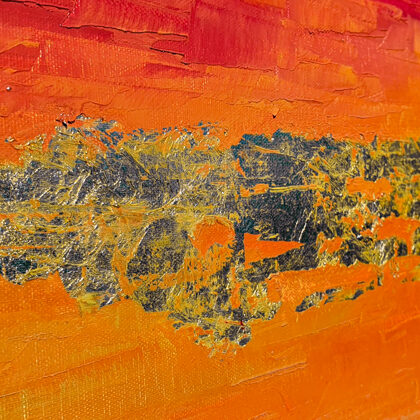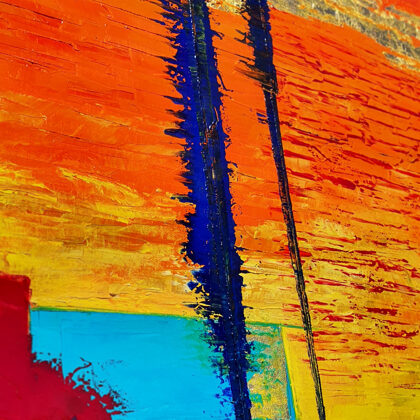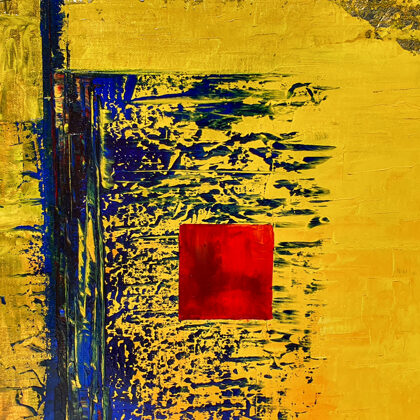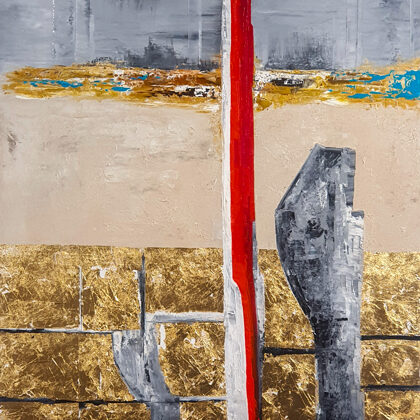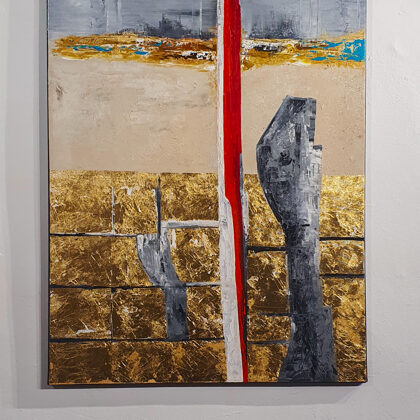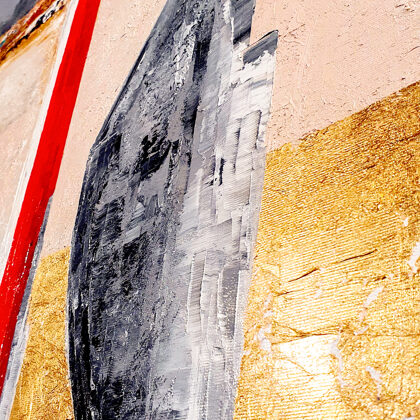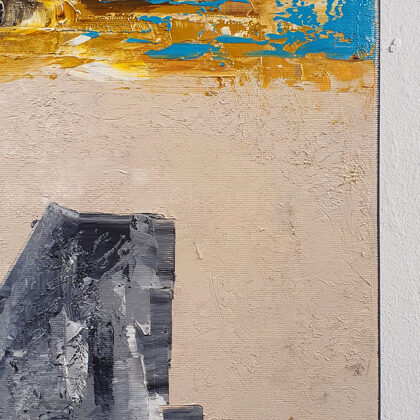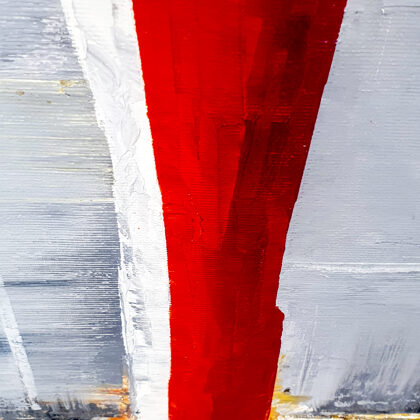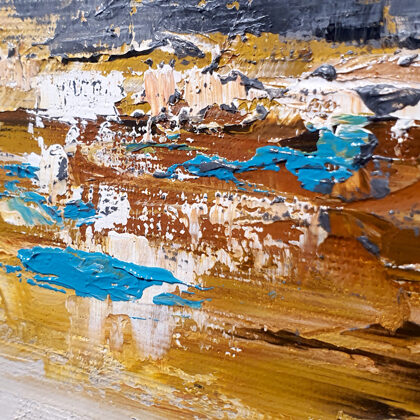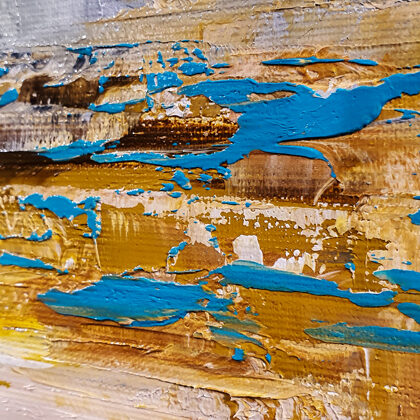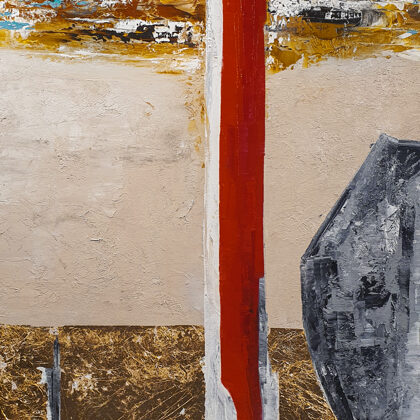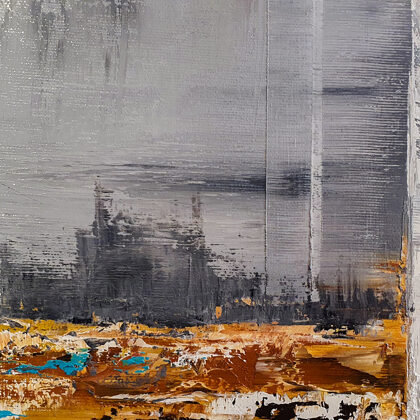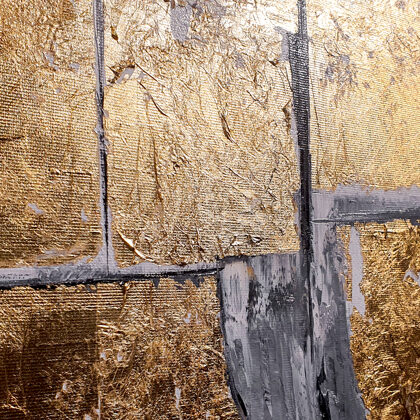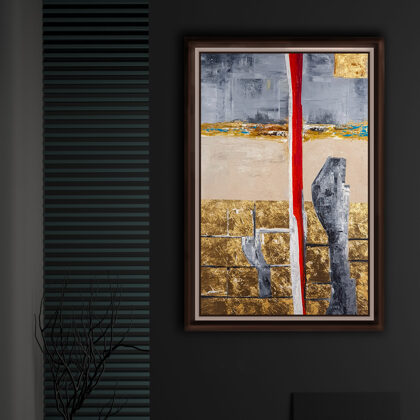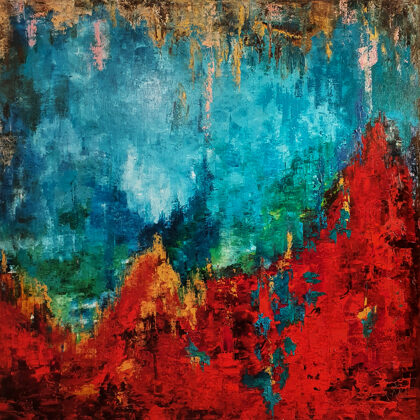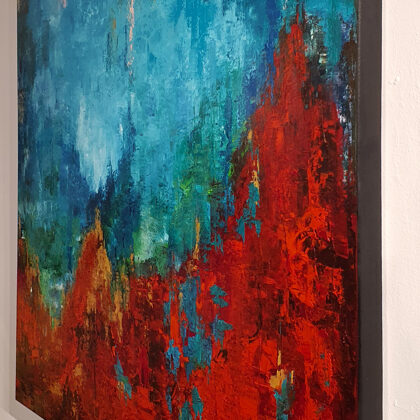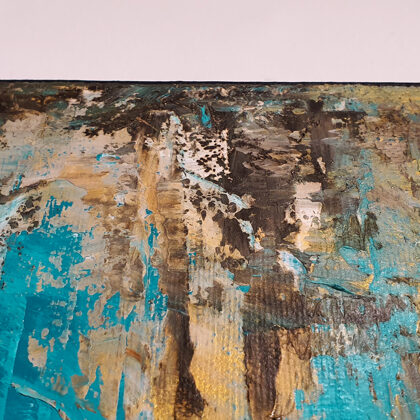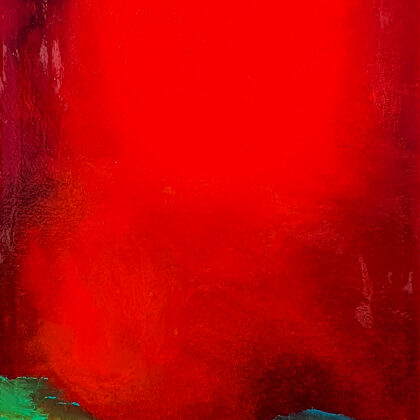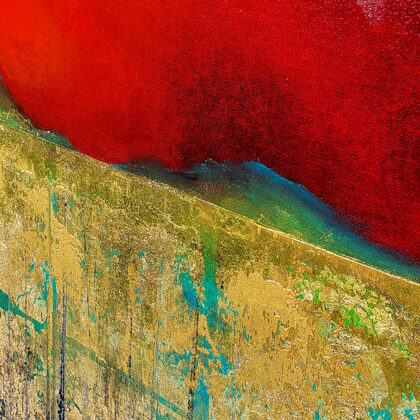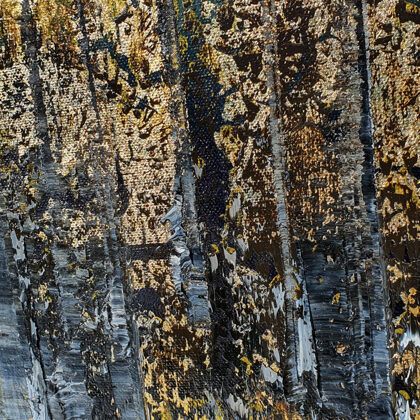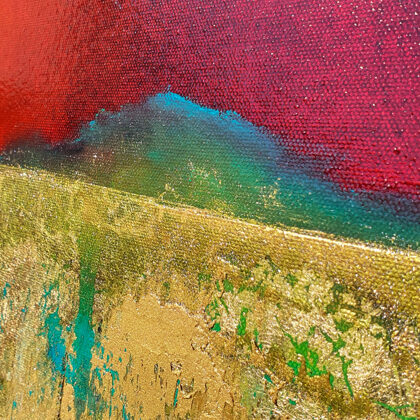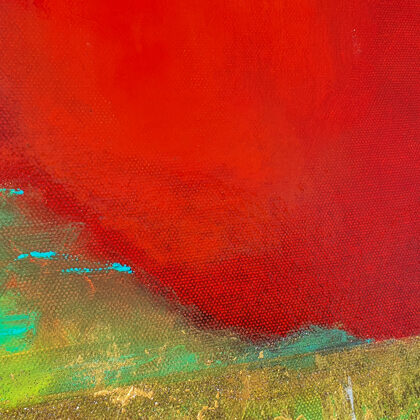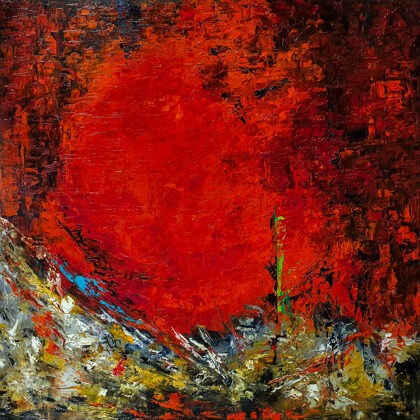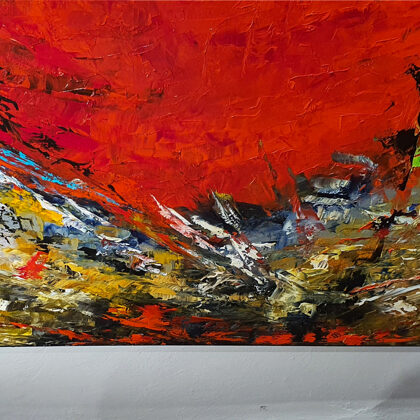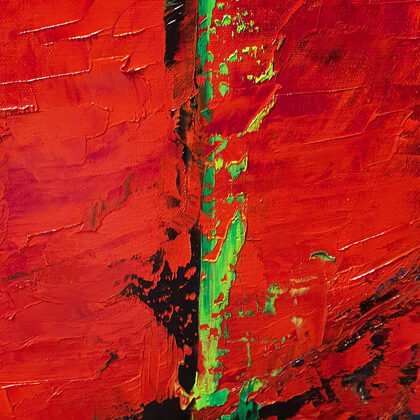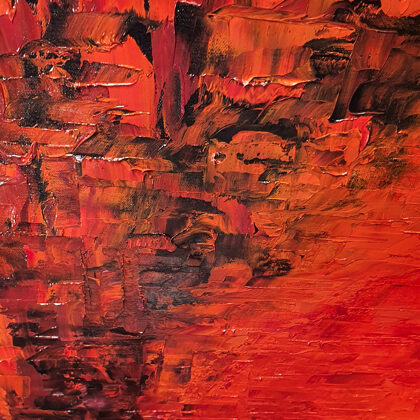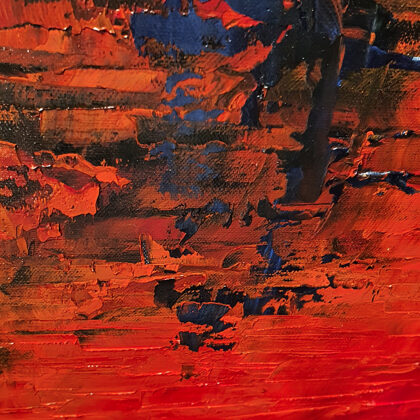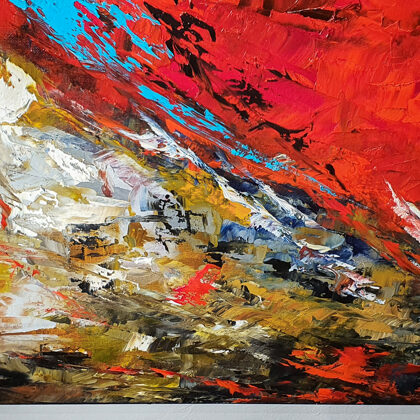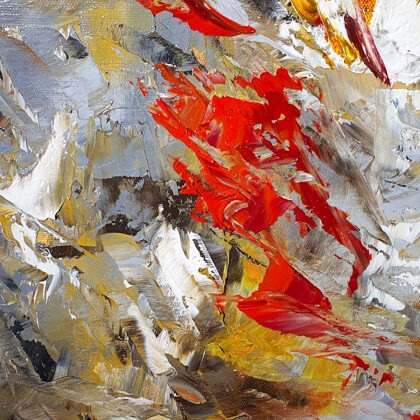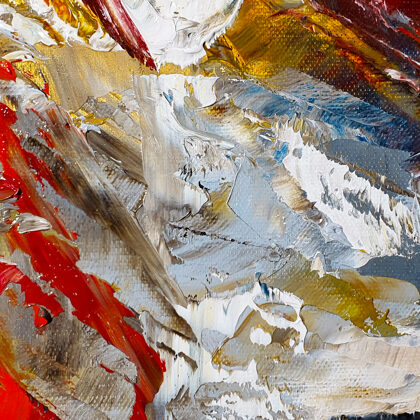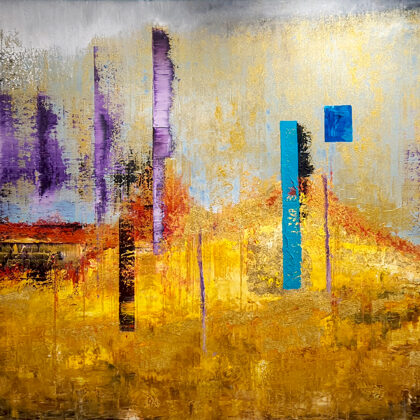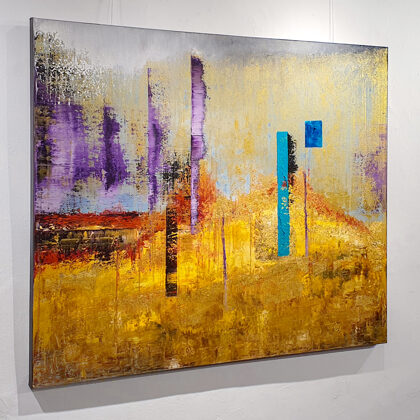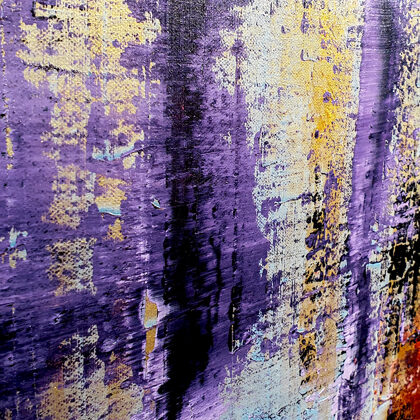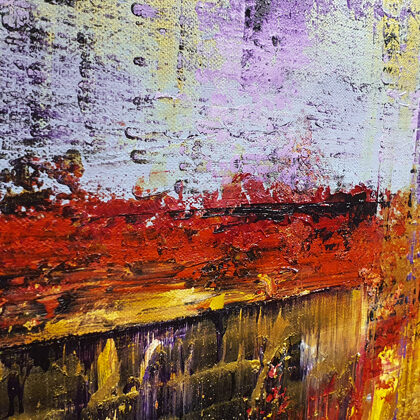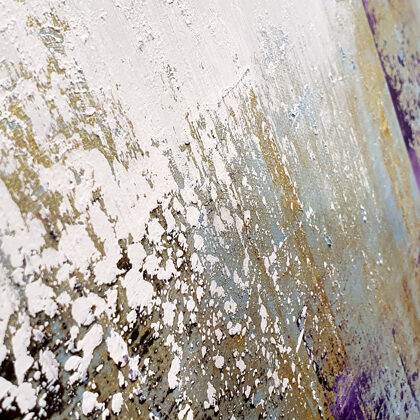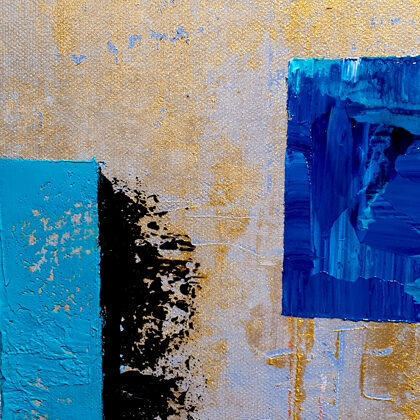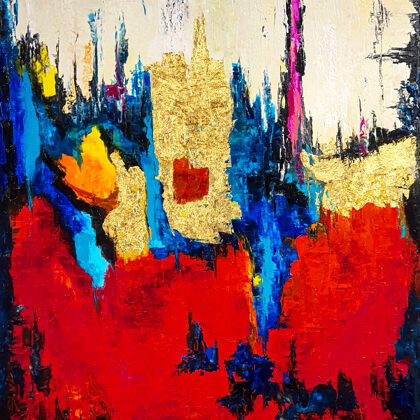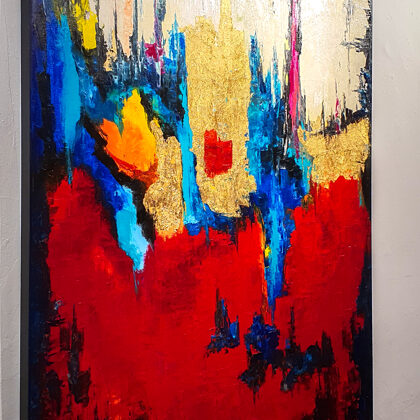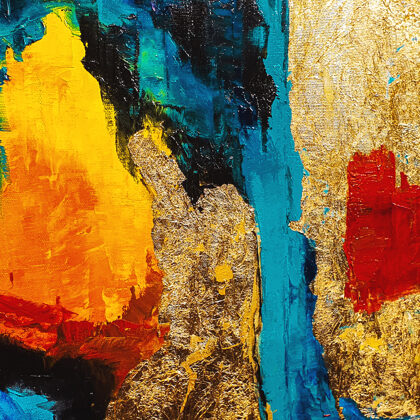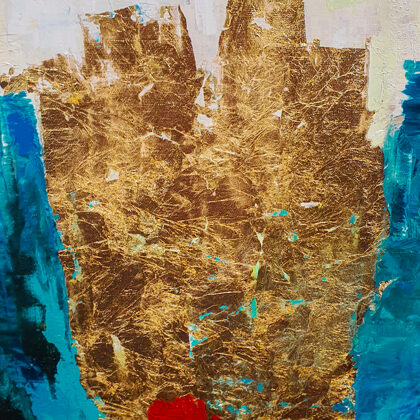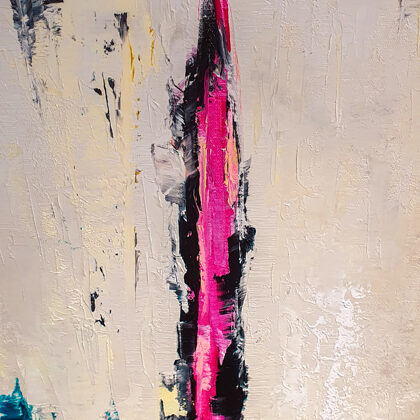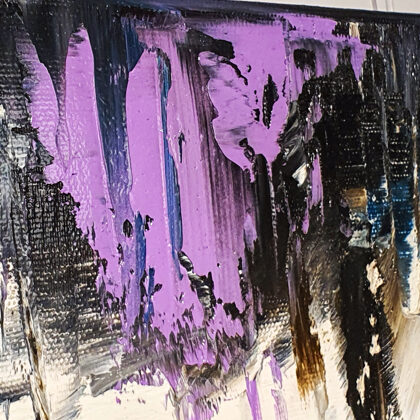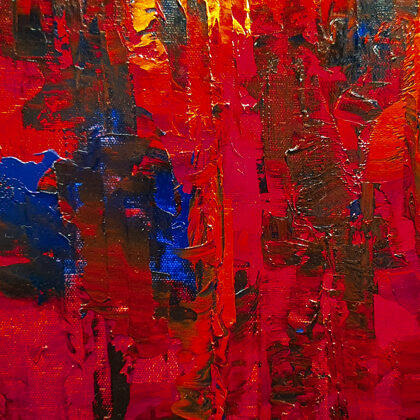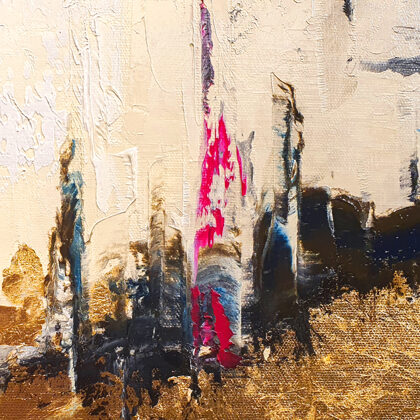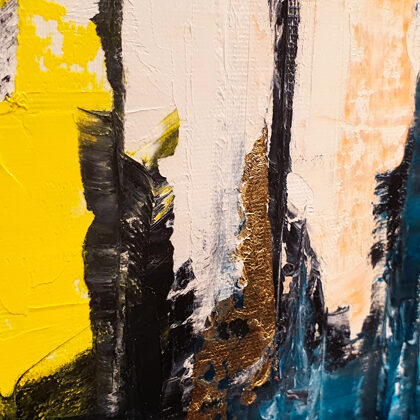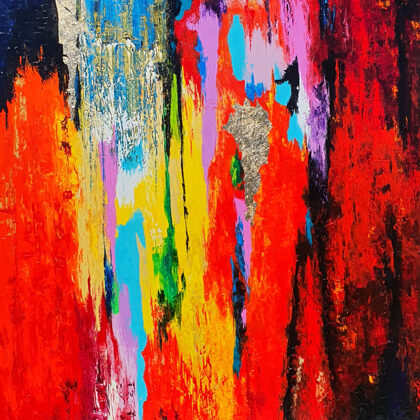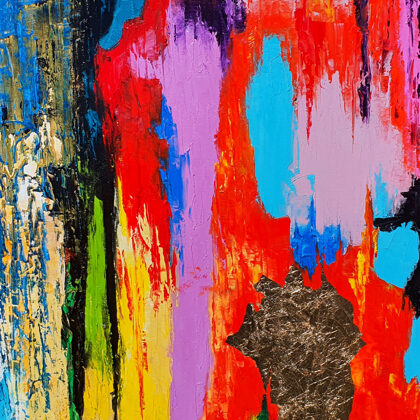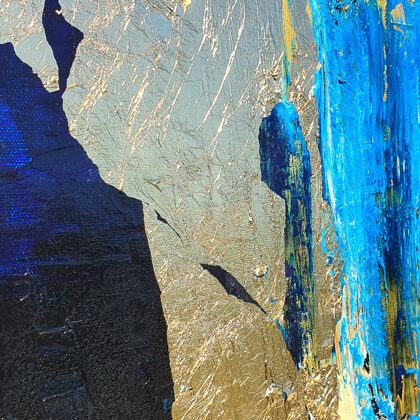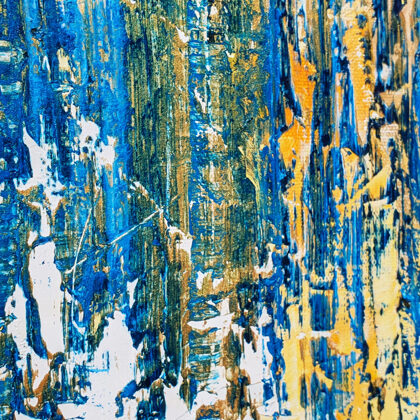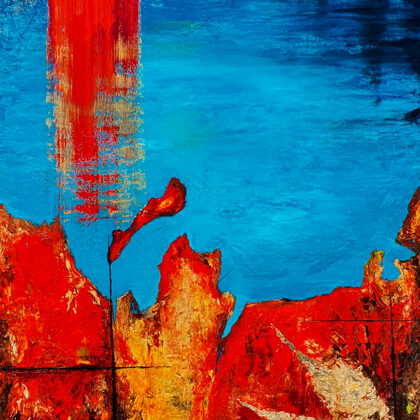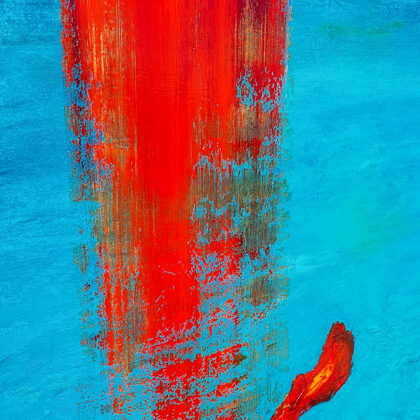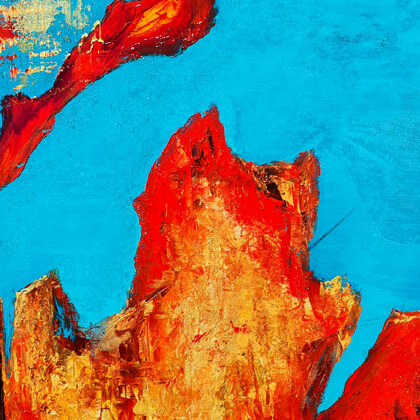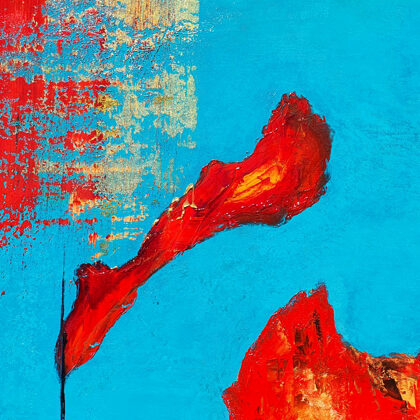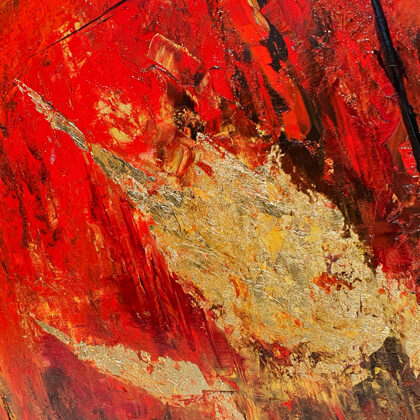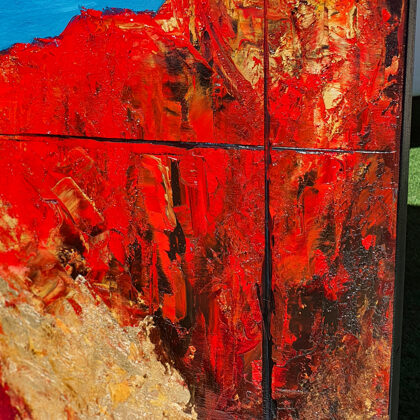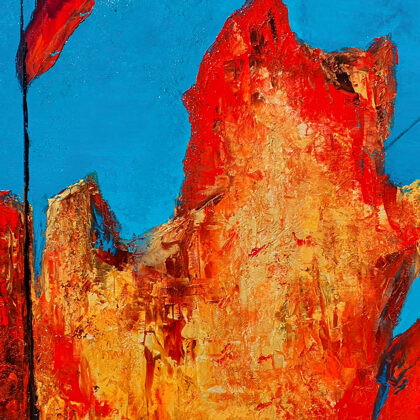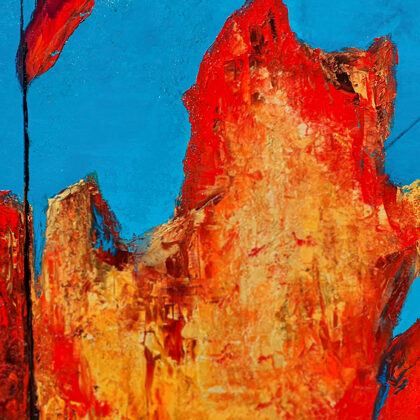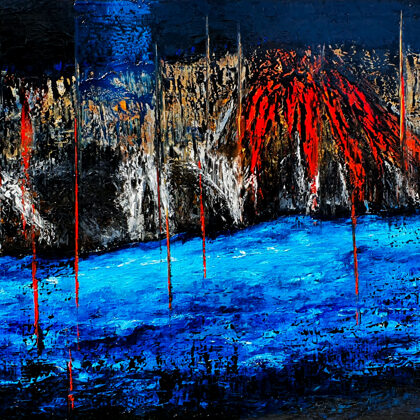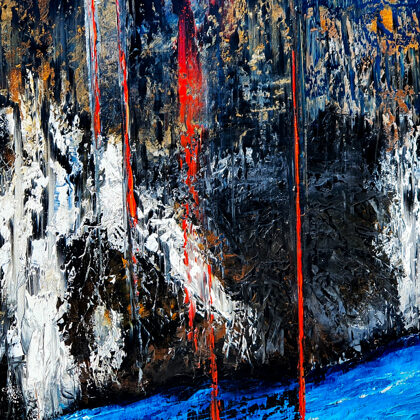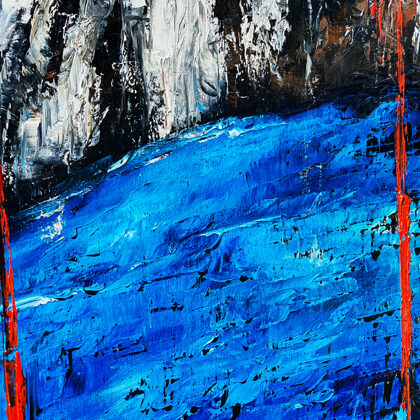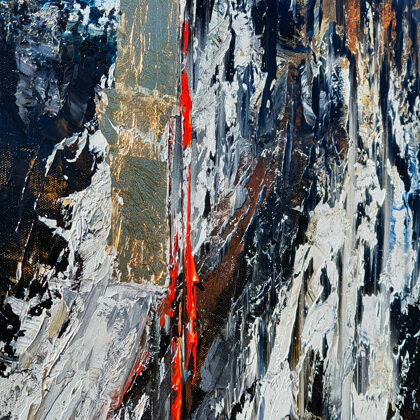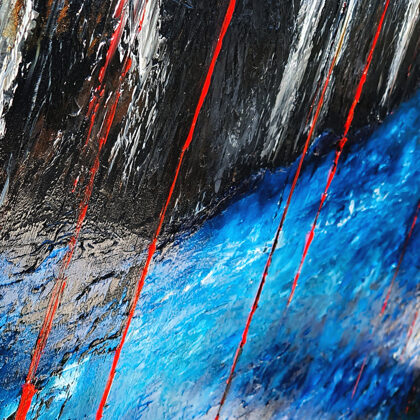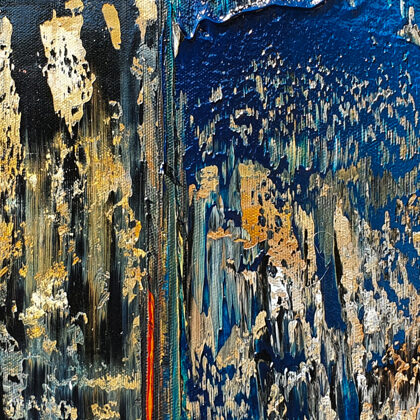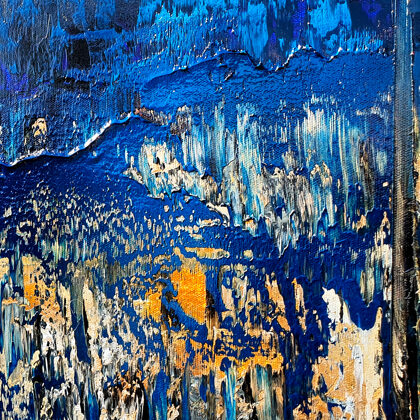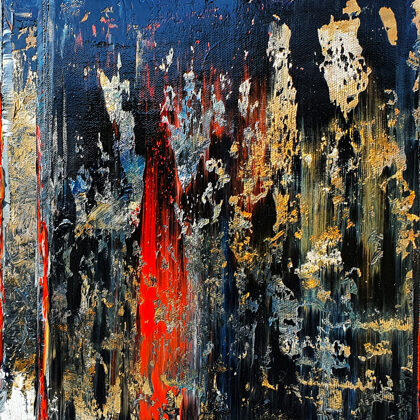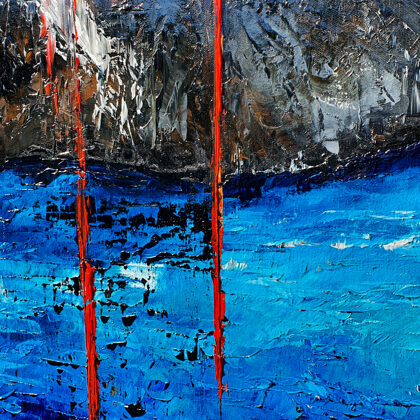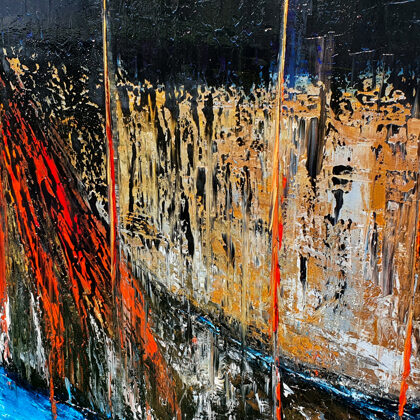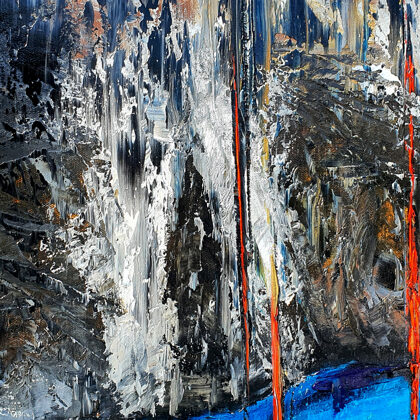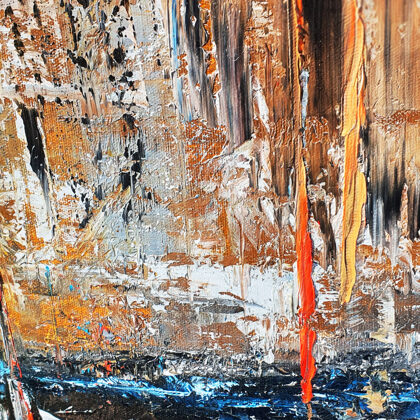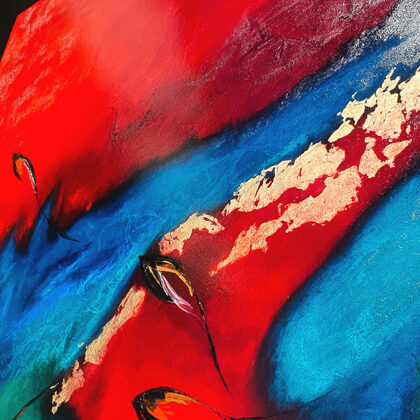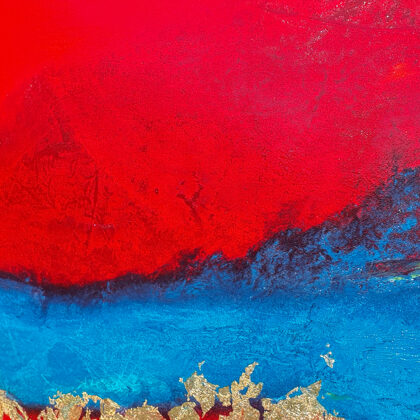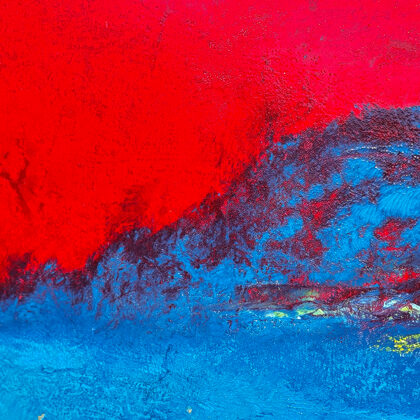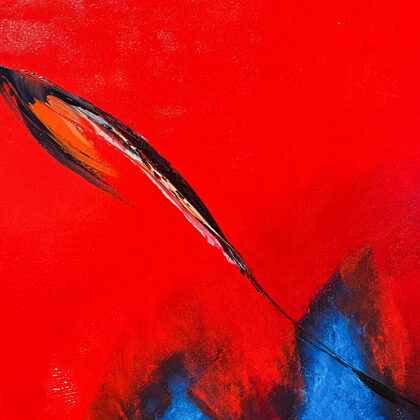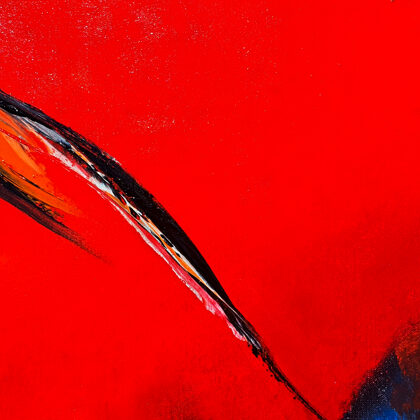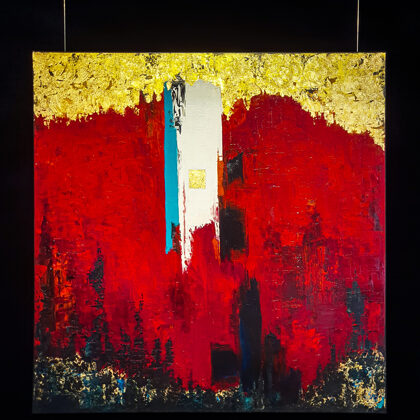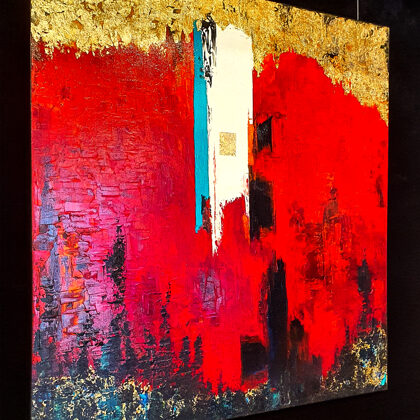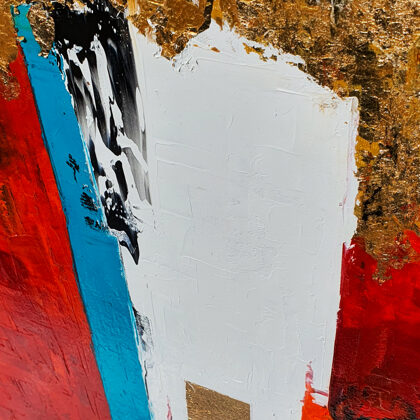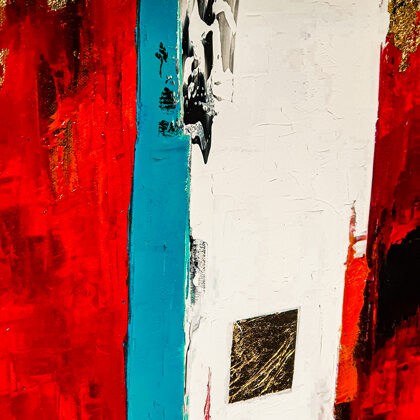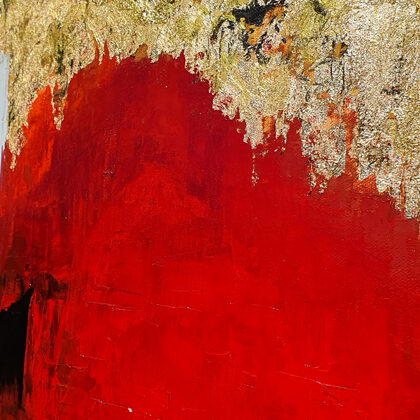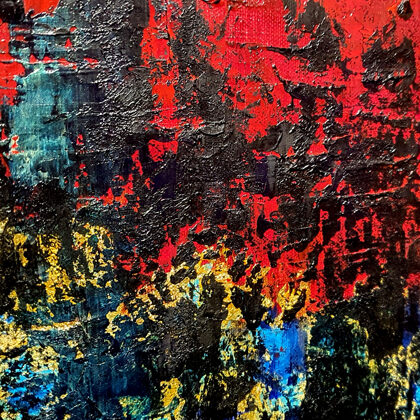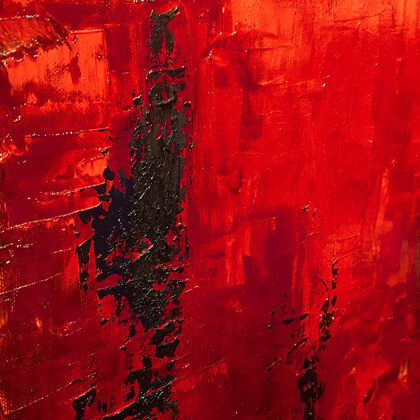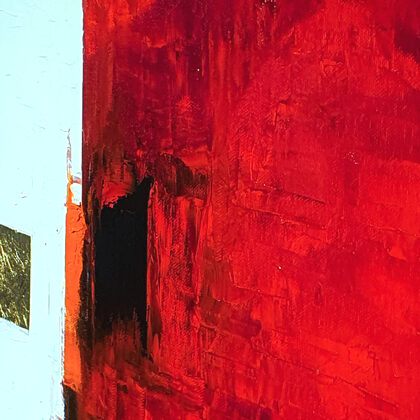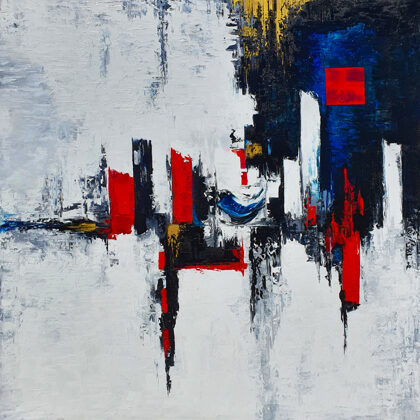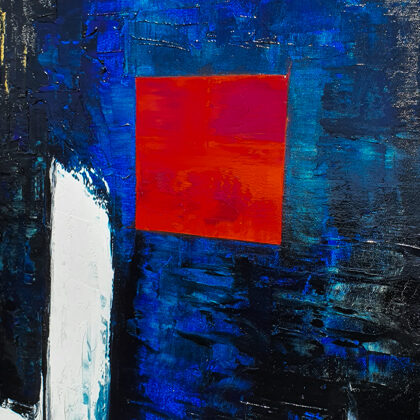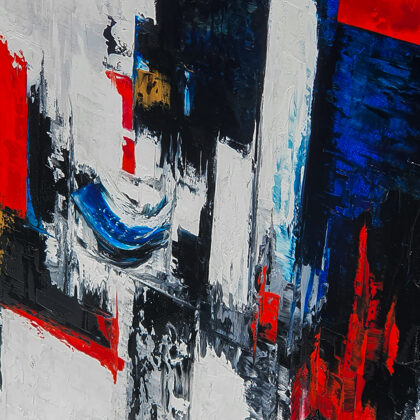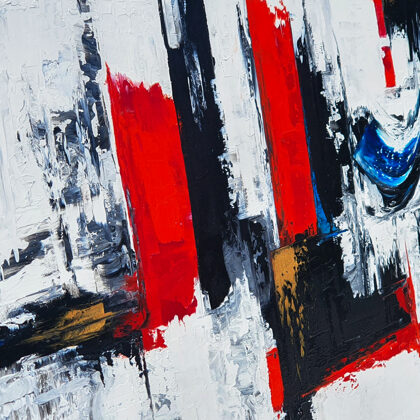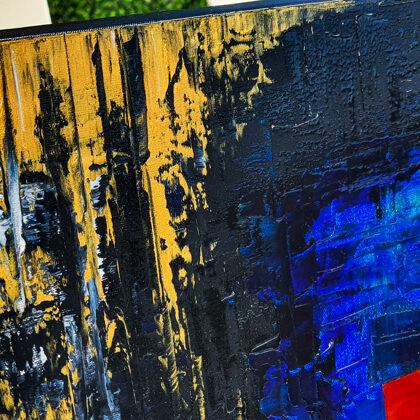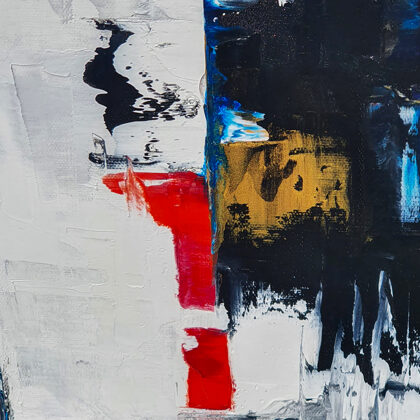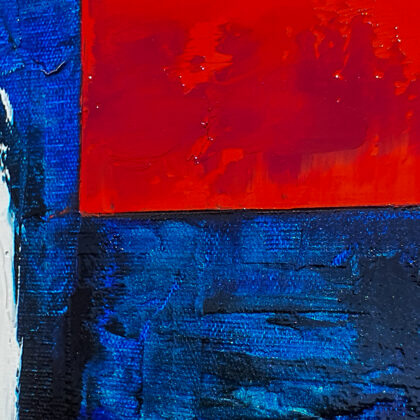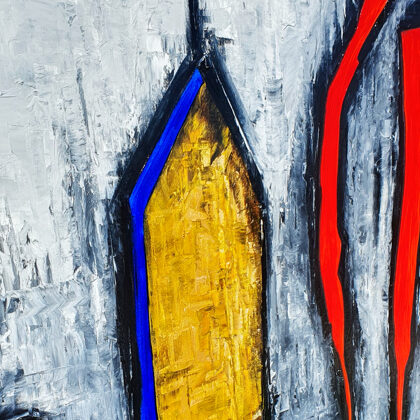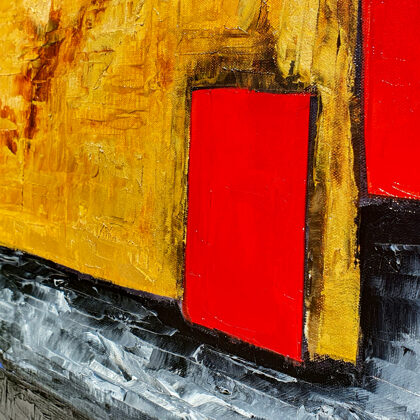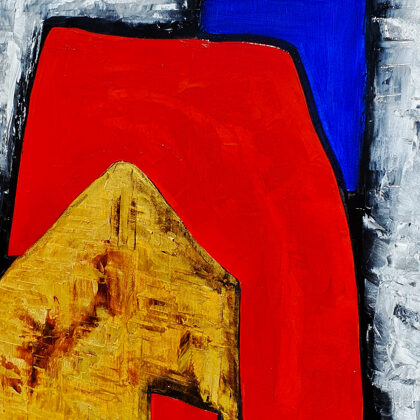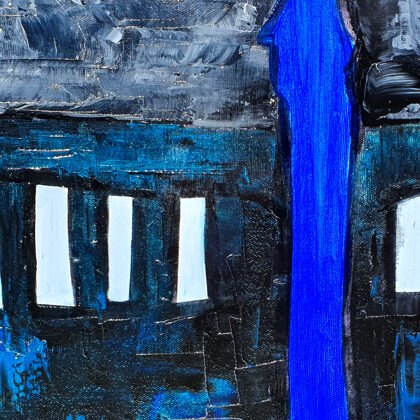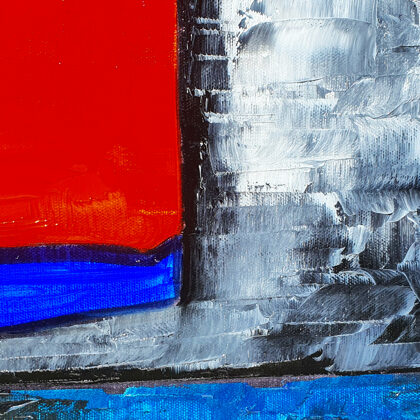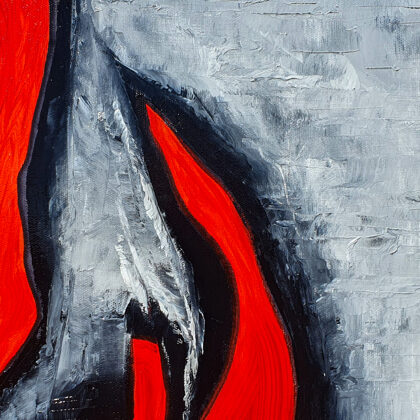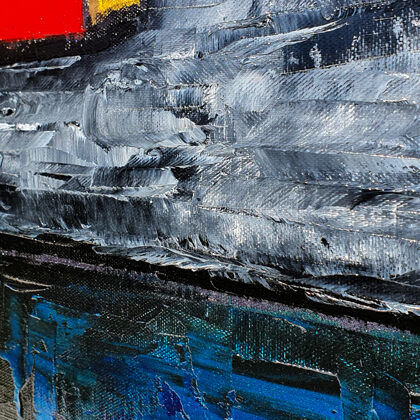Germanicus Iulius Caesar - The Greatest Emperor Who Never Reigned in Rome
- 120 x 100 cm
- Oil-gold-canvas
- Place and date of creation: Sitges, 2022
- The artwork is part of 'Period of the Imperial Rome' collection
- The artwork is privately owned
'The ‘Germanicus Iulius Caesar’ is an extremely important work of the exhibition because it tells the story of the deeds of one of the greatest emperors of Rome.
Tamás Náray incorporates his favorite colors into this upsetting work: crimson red and lapis lazuli blue, colors that rhyme powerfully with beloved colors of ancient Rome. In this work we also encounter a rich gold plating that fills almost half of the frame, with beautifully executed application despite that all of this is a very complicated task that requires expertise.
The composition of the work and emerging peaked shapes evoke the greatness of the emperor, but the darkening casts ominous shadows: he was the one who gave life to two questionable figures, Nero and Caligula.' prof.dr. Valeriano Venneri
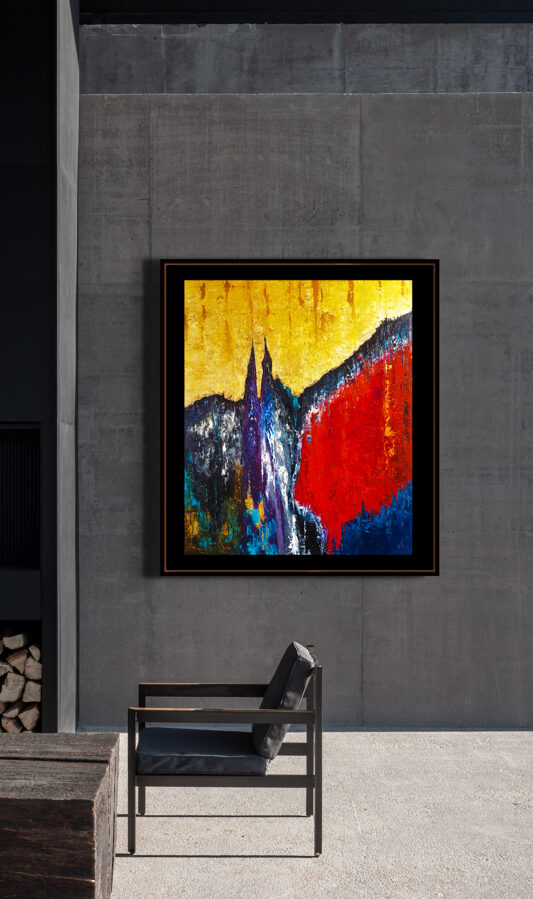
Atrium Vestae
- 75 x 25 cm
- Oil-gold-canvas
- Place and date of creation: Sitges, 2022
- The artwork is part of 'Period of the Imperial Rome' collection
- The artwork is privately owned
'This jewelry of a painting, depicting the Temple of Vesta in the Roman Forum, perfectly captures the cult of the priestesses and the importance surrounding it. Tamás Náray - with colors of almost otherworldly powers - imagines the columns inside the Vesta temple, consecrated to the goddess Vesta, under whose protection the Sacred Fire flickers. An eternal flame that must never go out. A fire that must burn until the end of time. Had it ceased, it would be a harbinger of bad omens.
Tamás, deliberately with no sadness, asks us to understand, to believe that, contrary to what we would think, the Roman world was a world full of colors and not all stone-white as we see it today. The combinations of colors and shades are brilliant, all this requires surgical precision from the artist. Brushes of all sizes and small spatulas are used in each segment, each of which is used to obtain a different, perfect finish of sometimes as little as a few square centimeters.' prof.dr. Valeriano Venneri
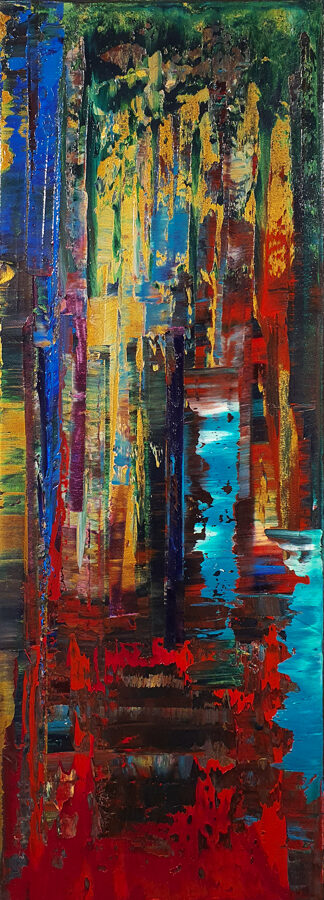
The Adopted - The Reign of Antoninus Pius
- 120 x 120 cm
- Oil-gold-canvas
- Place and date of creation: Sitges, 2022
- The artwork is part of 'Period of the Imperial Rome' collection
- The artwork is privately owned
'The reign of Antoninus Pius from 138 to 161 was one of the most flourishing periods of Rome. Adopted by Adriano, Pius succeeded his foster father after his death. Tamás’s painting fully captures the environment of Pax Romana and its peaceful economy. It almost seems like a reinterpretation of the ‘Allegory of Good and Bad Government’, a three-piece fresco by Ambrogio Lorenzetti, made a few centuries ago. Tamás balances the composition by placing geometric elements that allude to the borders of Brittany. The colors are well-measured and relaxing, changing shades in a shrewd and intelligent manner without creating aesthetic controversy for the observer. It’s a heartwarming experience to stand before the artwork.' prof.dr. Valeriano Venneri
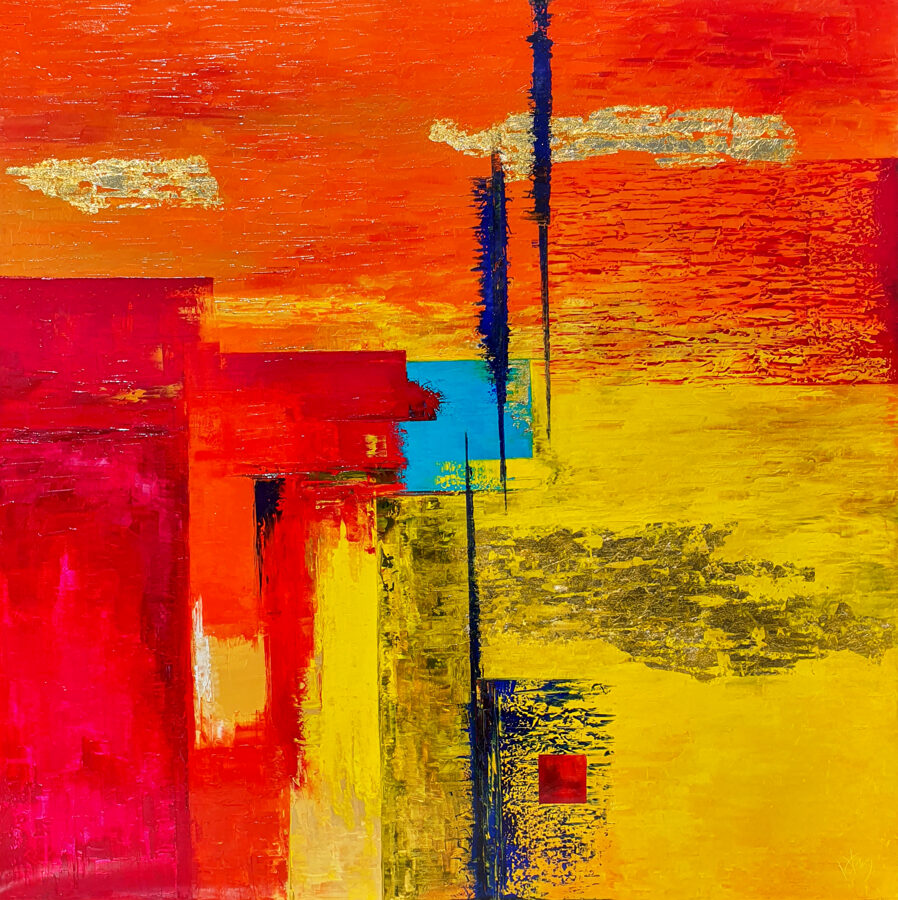
The Judgment - The King of the Jews Before Pontius Pilate
- 120 x 80 cm
- Oil-gold-canvas
- Place and date of creation: Sitges, 2022
- The artwork is part of 'Period of the Imperial Rome' collection
- The artwork is privately owned
'The work titled ‘The Judgment’ commemorates the dramatic moment when Jesus stands before Pontius Pilate.
Pilate, as is well known, does not assume authority and passes the right to judge: in the end Jesus is condemned because he proclaims himself the king of the Jews. The staff representing the snake has multiple meanings: the snake of evil and also the snake that deceives humanity in the story of Adam and Eve, and the court before which Jesus is dragged after torture and where it is pronounced: Ecce Homo! But Pilate only washes his hands.
Priming the canvas to be able to hold pastels is a task of great care and professionalism and requires a lot of patience. The tones of gray and beige elevate the work from mundane existence. The gold plates have symbolic significance: they represent the via Dolorosa, the Way of Suffering. Tamás Náray's advanced gilding technique approaches the level of the great masters of the Italian Renaissance.
The red pointed shape refers to the lance that will eventually release Jesus from his pain.' prof. dr. Valeriano Venneri
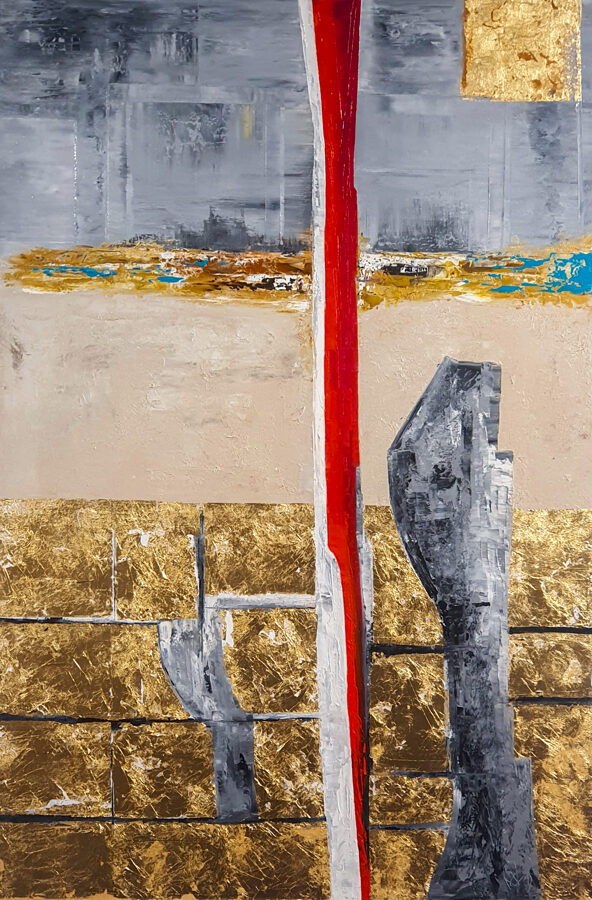
Grove in Aricia - The True Story of Egeria and Diana
- 100 x 100 cm
- Oil-gold-canvas
- Place and date of creation: Sitges, 2022
- The artwork is part of 'Period of the Imperial Rome' collection
- The artwork is privately owned
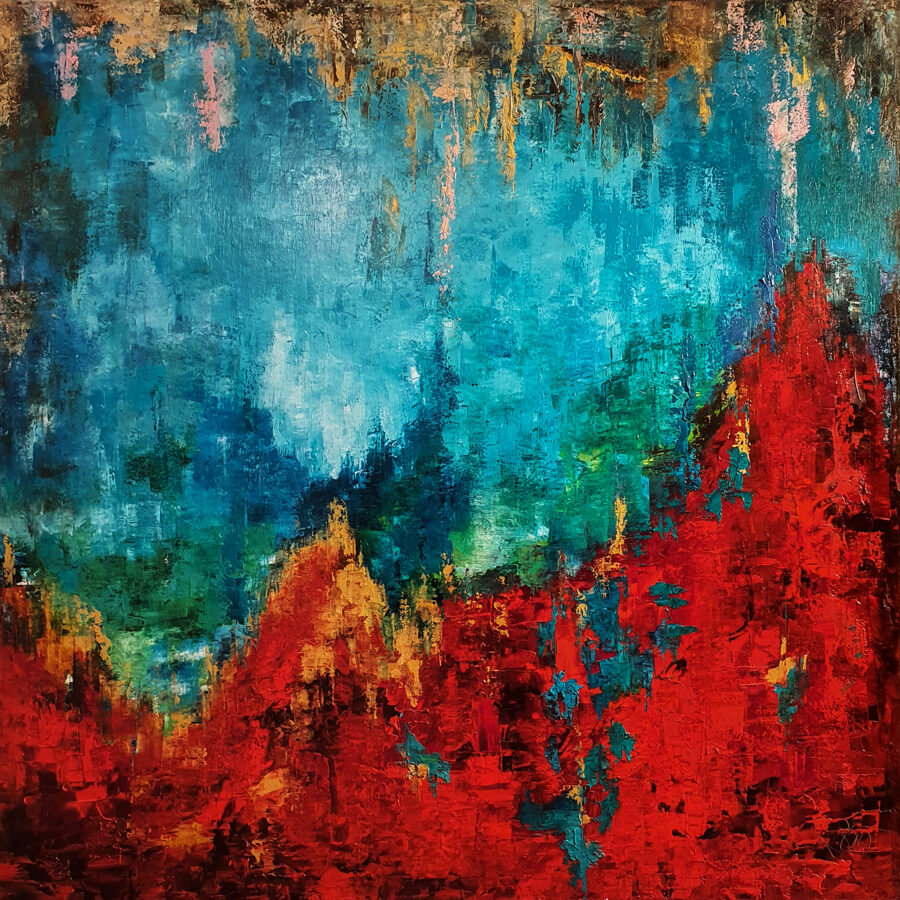
Diocletianus 303-313
- 150 x 50 cm
- Oil-gold-canvas
- Place and date of creation: Sitges, 2022
- The artwork is part of 'Period of the Imperial Rome' collection
- The artwork is privately owned
'Diocletian is a controversial, questionable emperor, but his importance is outstanding. The first violent persecution against Christians took place in the years indicated in the title.
The billowing shades of red suggest sinister omens, the outcomes of which are as painful as they are cruel. In the lower part of the frame the artist - with great intuition and brilliant technical knowledge - gives us a glimpse into the history of the three crosses, this time again by dividing the foreground to three units: trapped between the heavy lines the visual elements of the three merciless crucifixions come to life. In admiration of the painting we remember Jesus of Nazareth, as well as the two thieves Titus and Timaco. The downwards crucifixion of St. Peter also unfolds.' prof.dr. Valeriano Venneri

Caesar and Cleopatra
- 120 x 120 cm
- Oil-gold-canvas
- Place and date of creation: Sitges, 2022
- The artwork is part of 'Period of the Imperial Rome' collection
- The artwork is privately owned
'The ‘Caesar and Cleopatra’ is an extremely passionate piece. A passionate story about the heart which is embodied by the artist with an endless red swirl. The work symbolizes the self-devouring love that was ignited between Julius Caesar and the young Egyptian Cleopatra.
A tragic love, resulting in the fruit who is Cesarion, the illegitimate boy, whose legitimization proves to be a struggle that costs everything.
The young and inexperienced ruler, the beautiful Cleopatra, sets out to seduce a mature and successful consul, Julius Caesar. He pushes himself, for the sake of his empire, into a love that cannot have a happy ending, no matter how powerful and long it may be. We see the top notch mastery of Tamás Náray's color science on the canvas as he uses innumerable shades of burgundy, red and crimson: the countless shades of a single color is enough for the artist to convey infinity.' prof.dr. Valeriano Venneri

Dea Caelestis, Namely The Balance of The Divine Justice
- 100 x 120 cm
- Oil-gold-canvas
- Place and date of creation: Sitges, 2022
- The artwork is part of 'Period of the Imperial Rome' collection
- The artwork is privately owned
Aligning with the constellations of Virgo and Libra the artist brings the viewer into contact with many celestial deities by invoking the sky goddess Dea Caelestis. In Rome, Libra was a symbol of divine justice and earthly laws, something that was passed down to present days.
The collapsing geometric forms of calm violet shades lead the viewer into the slate gray timeless heights. Golden, fertile rain delivers the processes that keep the world in motion. The appearance of reds highlight the manifestations of the heavenly points on earth, as we must remember that in the Roman Empire divine and heavenly justice went hand in hand with earthly justice.' prof.dr. Valeriano Venneri
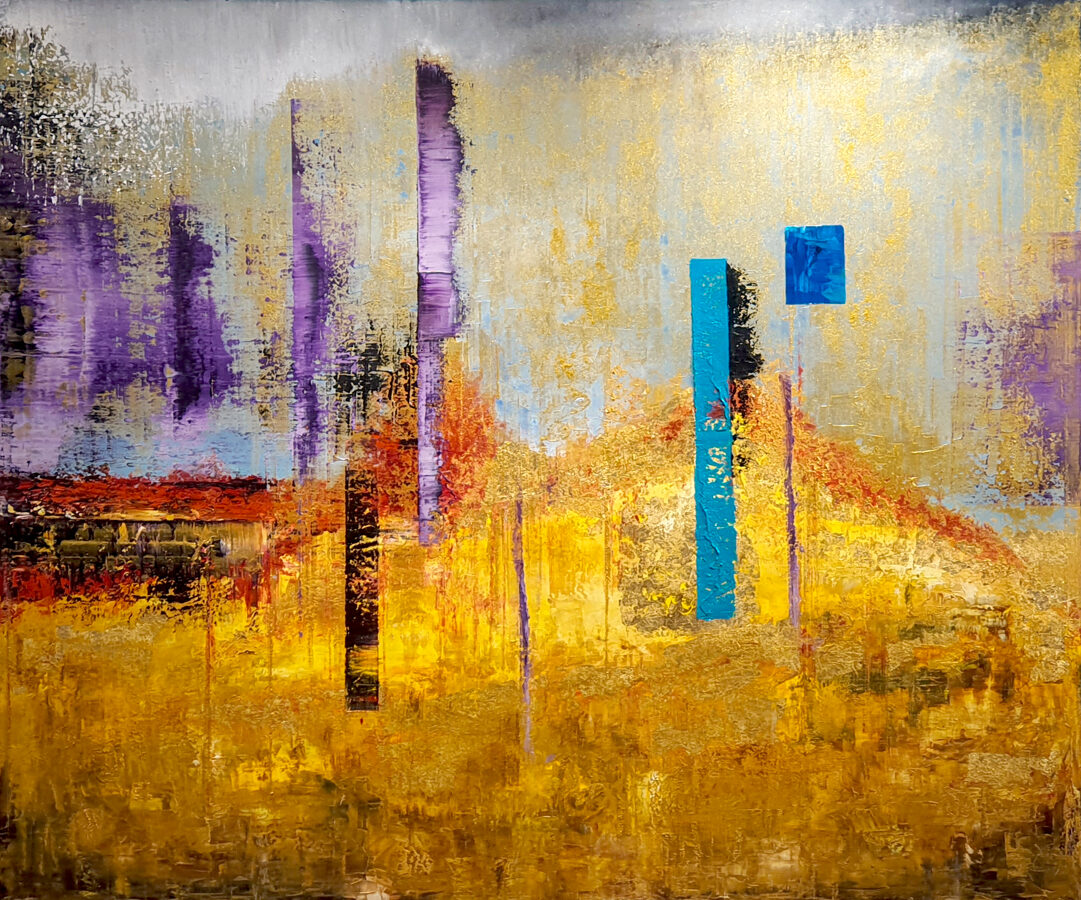
Fire Consecration - Mars Vigilia!
- 160 x 100 cm
- Oil-gold-canvas
- Place and date of creation: Sitges, 2022
- The artwork is part of 'Period of the Imperial Rome' collection
- The artwork is privately owned
'The consecrated fire is of fundamental importance in the history of many known and recognized ancient peoples, hence it has a prominent role in Roman life also. The ‘Fire Consecration’ by Tamás Náray is an extremely expressive work of art.
The fire, lit in honor of Mars, the protector of the city of Rome, is represented by soft coloring above like opal yellow white, and the golden bread and red wine are diversified with blue lapis lazuli. The intensity and countless shades of red tones emphasize the primacy of the god Mars in the life of the city of Rome and renew the protection resulting from it.' prof.dr. Valeriano Venneri
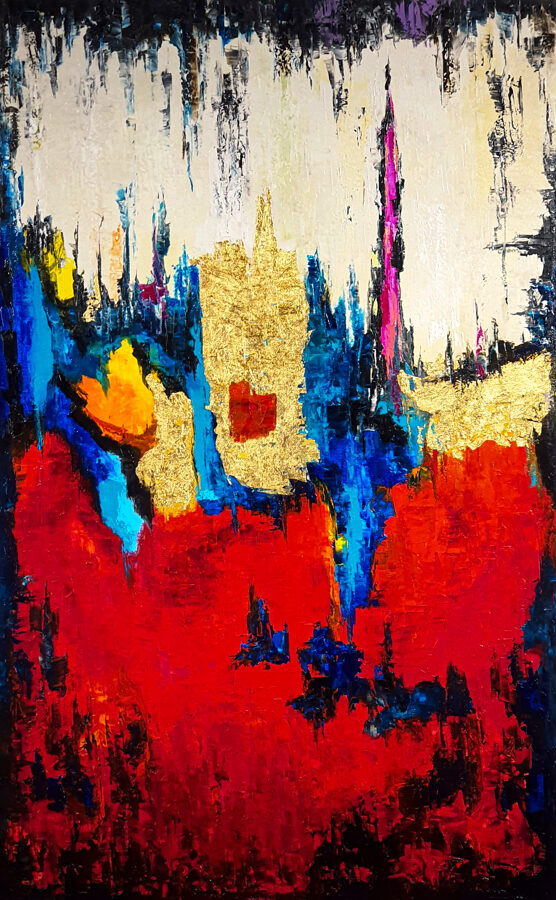
Flames of Museion
- 160 x 140 cm
- Oil-gold-canvas
- Place and date of creation: Sitges, 2022
- The artwork is part of 'Period of the Imperial Rome' collection
- The artwork is privately owned
'Building a large and lasting empire like Rome has positive aspects: the construction of monuments, aqueducts and very important road networks, however, the process of conquest also has tragic and dramatic aspects. In the painting ‘The Burning of the Mouseion’, the artist creates a very specific visual ensemble where he paints the flames precisely, as a result of which we can see the destruction of a world's culture. The details are abstract: each color carries a different meaning in the world of science and culture. In the middle of the frame a staring figure in a blue jacket appears, whose rigid immobility symbolizes the puzzledness of posterity. The Library of Alexandria will be consumed by flames.' prof.dr. Valeriano Venneri
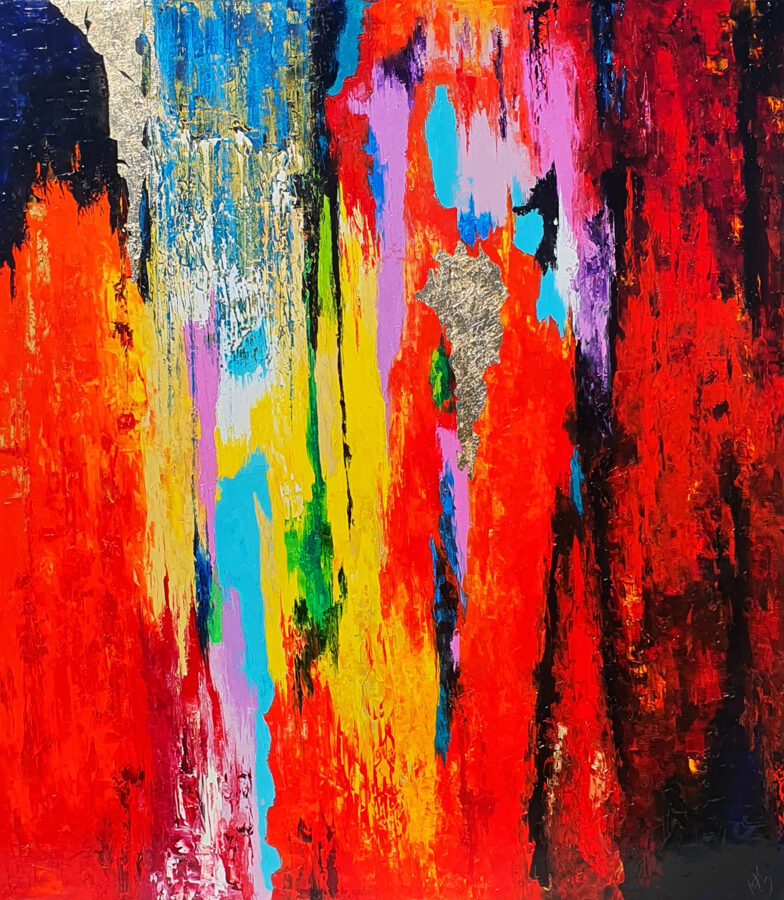
The Journey of Aeneas
- 160 x 140 cm
- Oil-gold-canvas
- Place and date of creation: Sitges, 2022
- The artwork is part of 'Period of the Imperial Rome' collection
- The artwork is privately owned
'With the painting of Aeneas, one of the founders of Rome, Tamás Náray tells the story of the journey and the adventures that we know from Virgil's masterpiece of the same title. After the Trojan War, Aeneas embarks on a long journey at sea, which leads him straight to the estuary of the Tiber, that is, to the future Rome.
In the artist's magnificent painting we can observe thousands of flowing shades of deep blue, turquoise, aqua and petrol blue, typical of the seas seen and sailed by Aeneas, a sea that almost inevitably merges together with the skies. With the red of double tone and meaning, we can remember his love for Dido on one hand, and the defeating of the Trojans on the other.' prof. dr. Valeriano Venneri
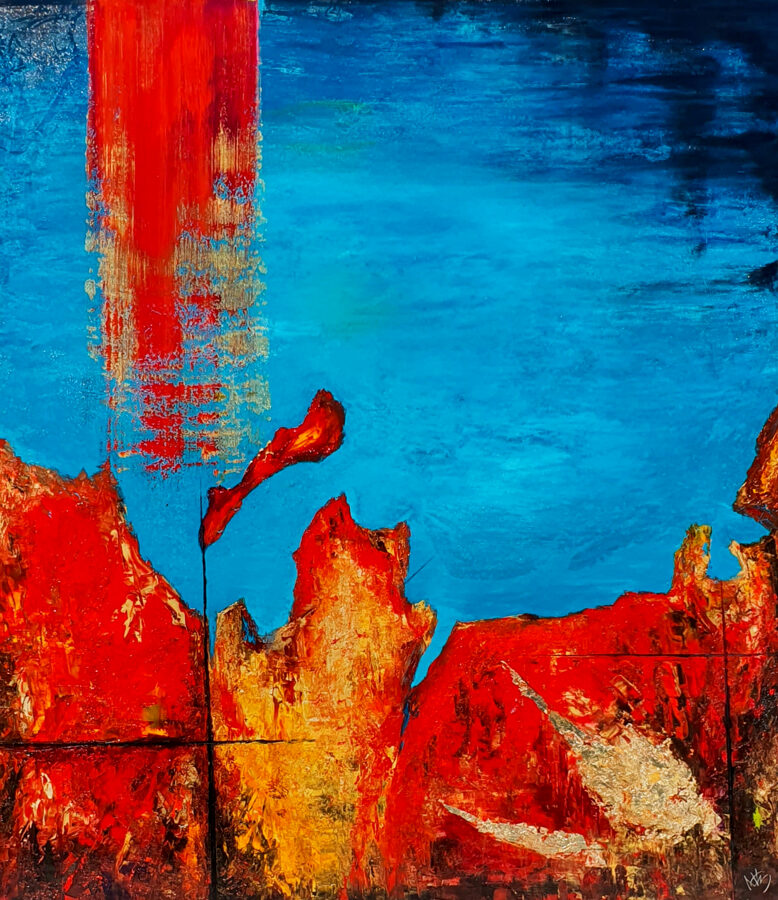
The Day, That Changed Everything (24 of August, AD. 79)
- 120 x 220 cm
- Oil-gold-canvas
- Place and date of creation: Sitges, 2022
- The artwork is part of 'Period of the Imperial Rome' collection
- The artwork is privately owned
'The still, created with impressive formal courage, captures a cathartic event. Despite the terrible destruction of the released energies, the wide, grandiose painting carries the possibility of ascension within it.' dr. Szilvia Hájer
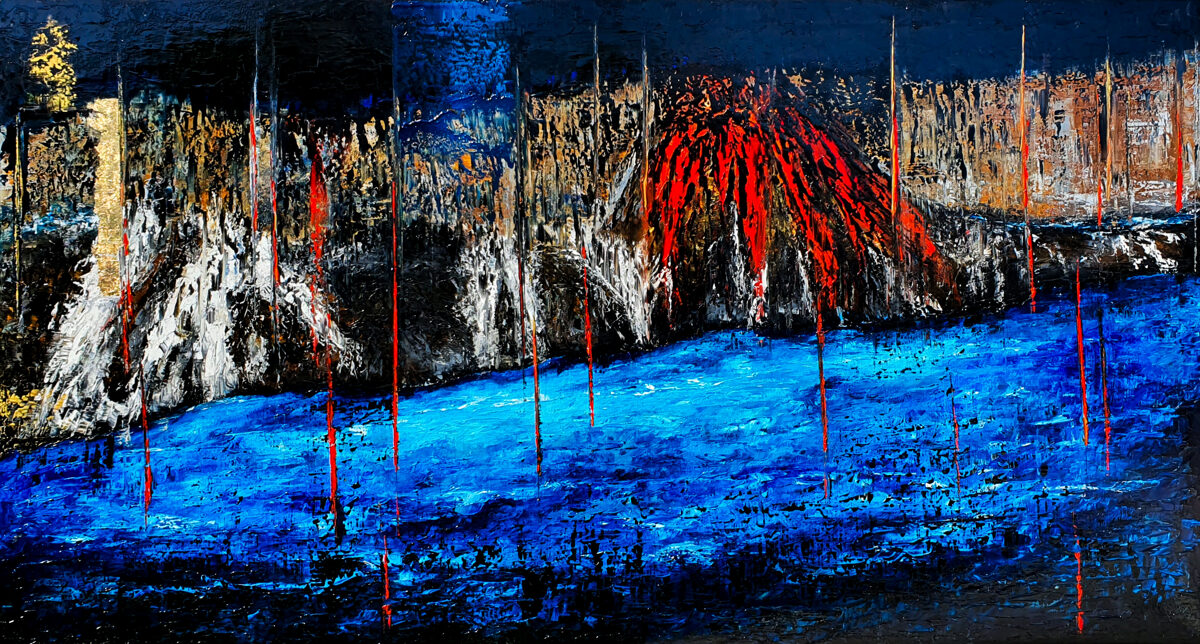
Geese of the Capitol
- 160 x 140 cm
- Oil-gold-canvas
- Place and date of creation: Sitges, 2022
- The artwork is part of 'Period of the Imperial Rome' collection
- The artwork is privately owned
'The event brought to the canvas takes place in 390 BC, on one of the seven hills of Rome, the Capitolium, where the geese also lived. The Gauls attack Rome and force the population within the walls without food. However, the goose is a sacred animal in Roman mythology, so their lives are spared. Under the cover of night the enemy sneaks up to the walls to raid the city, but the loud screeching and panicked flapping of the geese alerts Marcus Manlio, the former Roman consul, who thus can avert the lurking danger in time.
Tamás Náray creates a large-scale work of art in both design and dimensions to tell this story. The frame shows many clear and abstract references. Special mention should be made of the masterful blending of shades in the applied layers of paint: the use of red is downright brilliant, and the millions of delicate brushstrokes are exceptional, achieving such a transparency that can be seen in case of the yellows and greens on the blue coating.' prof.dr. Valeriano Venneri
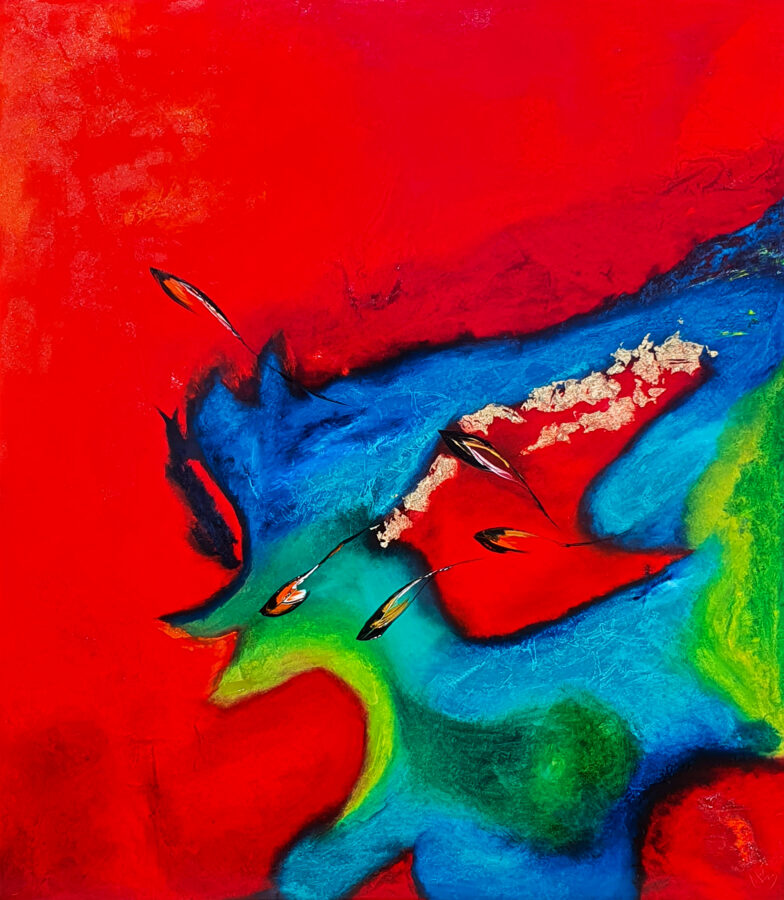
Dethronement of Romulus Augustulus
- 100 x 100 cm
- Oil-gold-canvas
- Place and date of creation: Sitges, 2022
- The artwork is part of 'Period of the Imperial Rome' collection
- The artwork is privately owned
'The dethronement of Romulus Augustulus marks the end of the Western Roman Empire. His short reign of only ten months coincides with this mighty event. We remember that the Eastern Roman Empire actually lasted until 1453, til the Ottoman siege of Constantinople and its failure. In the interpretation of this tragic event, the artist highlights the memories of the wealth, the painful crisis and the end of the Empire. The upper part interwoven with gold plating reminds us of the seemingly invincible imperial era of great conquests, a ‘golden’ era; the center of the frame seems solid, but the geometric elements entering the whirling red surface indicate breaches; the use of the black, rough texture at the bottom refers to the sediment that marks the end of the Western Roman Empire.' prof.dr. Valeriano Venneri
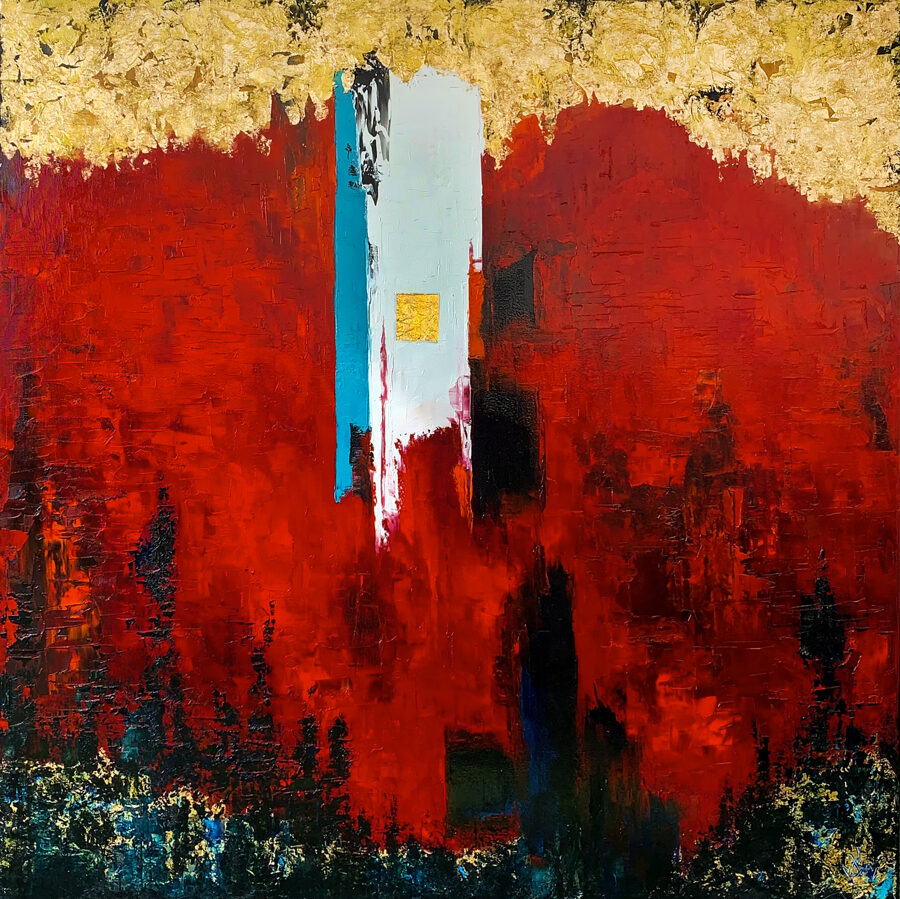
Occupation of Judea
- 120 x 120 cm
- Oil-gold-canvas
- Place and date of creation: Sitges, 2022
- The artwork is part of 'Period of the Imperial Rome' collection
- The artwork is privately owned
'The dramatic power of the impulses emerging on the off-white surface of timeless existence weaves the events of the province of Judea into a theatrical order. The upward and downward bursts - progressing in time and space - of the form running along the axis of the image field indicate the succession of rulers and territorial changes. The alternating dynamics of the black accents refer to the strife between the powers that decimated Abraham's people, in the fiery color combinations that accompany the dark elements, the invading aliens wash away their sins with the blood of the innocent. In the clay-yellow details the laws engraved on the stone tablet, handed to Moses, appear.' dr. Szilvia Hájer
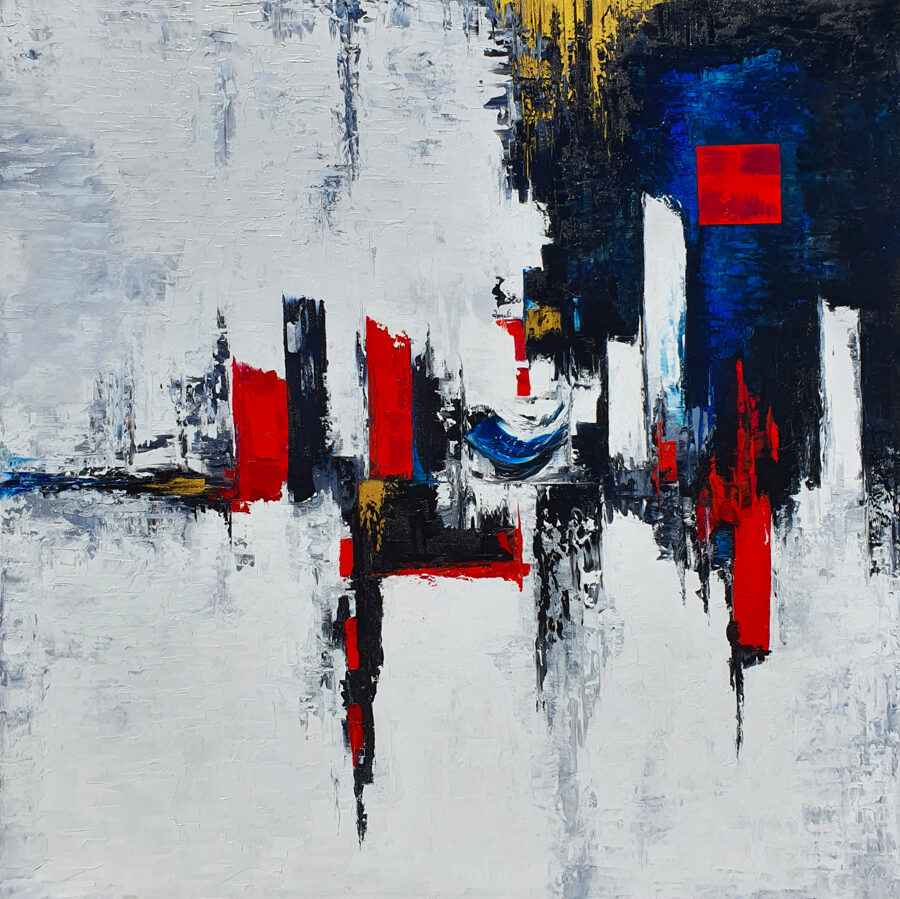
The Third Temple
- 120 x 120 cm
- Oil-gold-canvas
- Place and date of creation: Sitges, 2022
- Te artwork is part of 'Period of the Imperial Rome' collection
- The artwork is privately owned
'In addition to the colors, the numbers also have symbolic significance on the artwork. The ten tables and ten menorahs of the original place of worship are represented by the white stripes, and the ten white elements refer to the ten lost tribes in addition to the Ten Commandments. The two royal blue stripes represent the two cherubs guarding the Ark of the Covenant.' dr. Szilvia Hájer
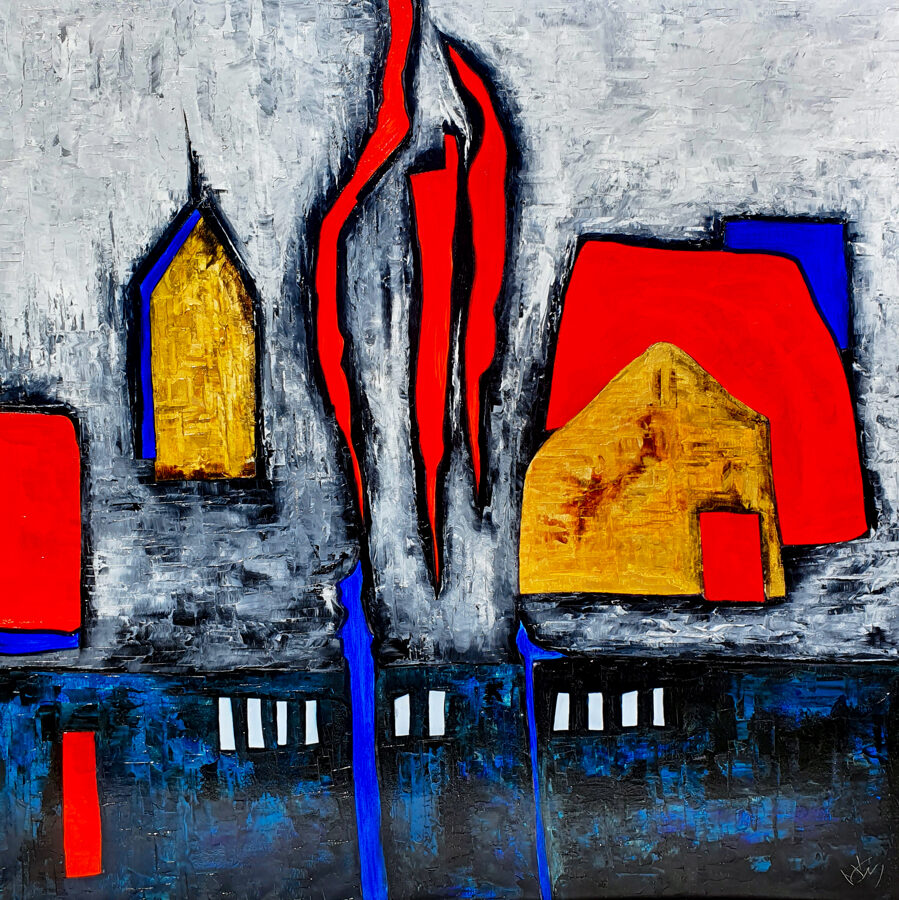
Juno Meets Iris the Nymph
- 80 x 80 cm
- Oil-gold-canvas
- Place and date of creation: Sitges, 2022
- Te artwork is part of 'Period of the Imperial Rome' collection
- The artwork is privately owned
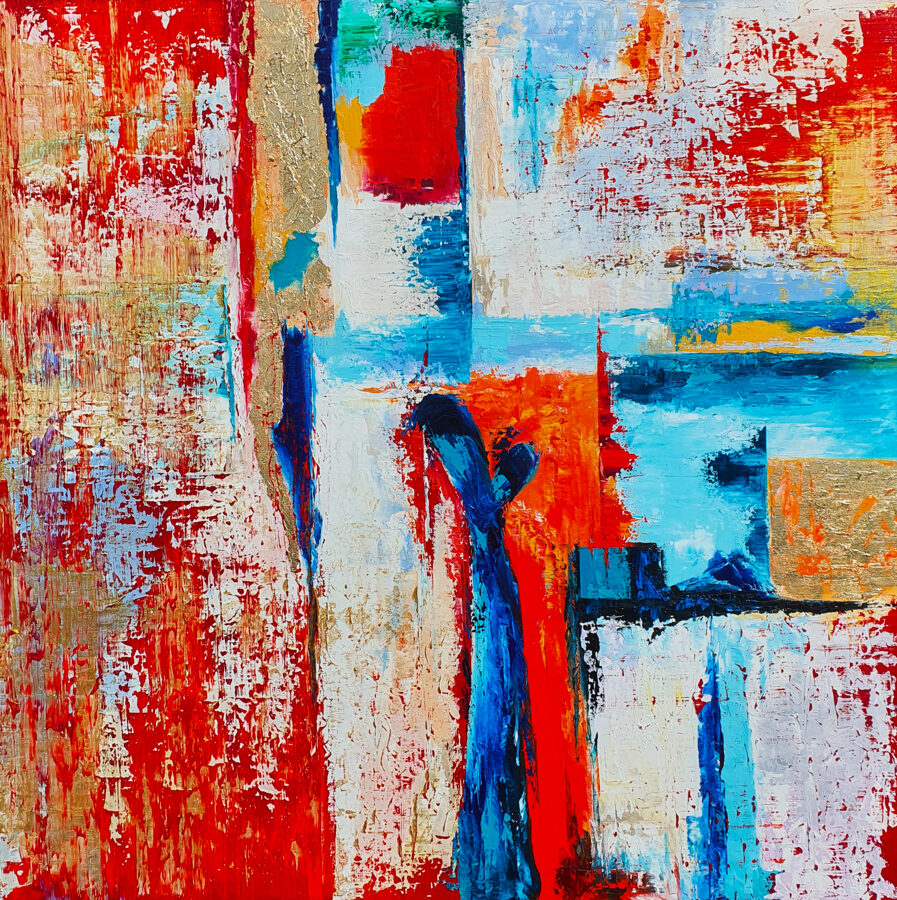
War of Mithridates and Sulla
- 100 x 100 cm
- Oil-gold-canvas
- Place and date of creation: Sitges, 2022
- Te artwork is part of 'Period of the Imperial Rome' collection
- The artwork is privately owned
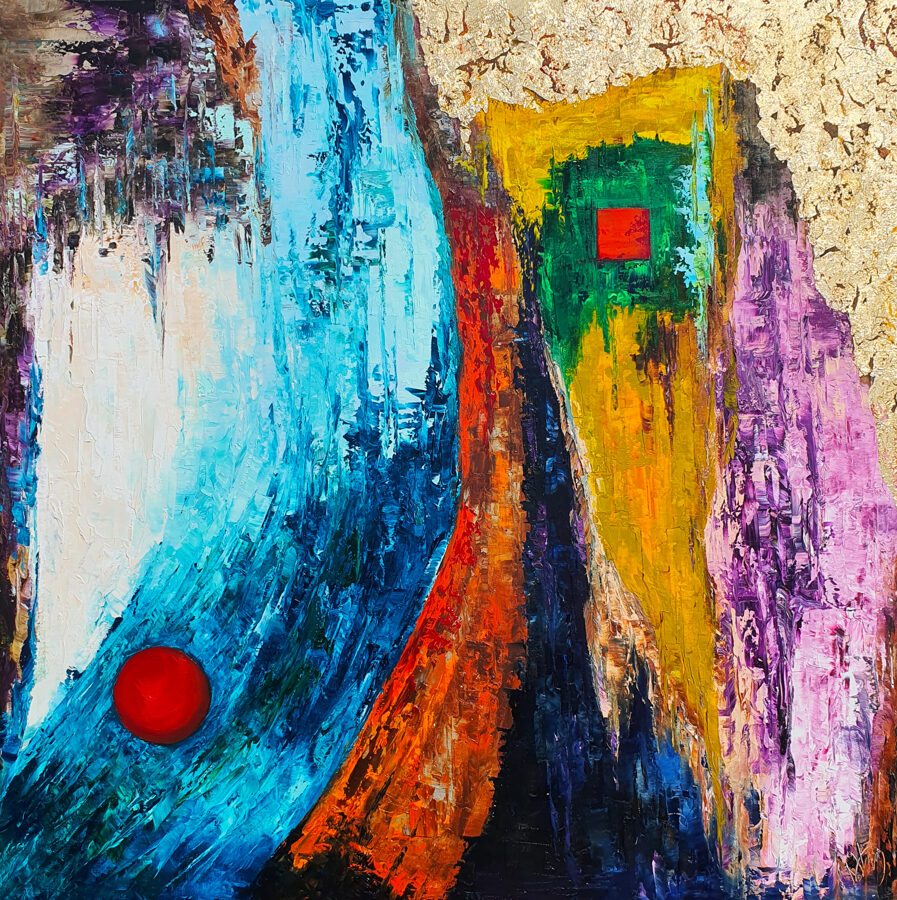
The Divided Empire
- 50 x 50 cm
- Oil-gold-canvas
- Place and date of creation: Sitges, 2022
- Te artwork is part of 'Period of the Imperial Rome' collection
- The artwork is privately owned
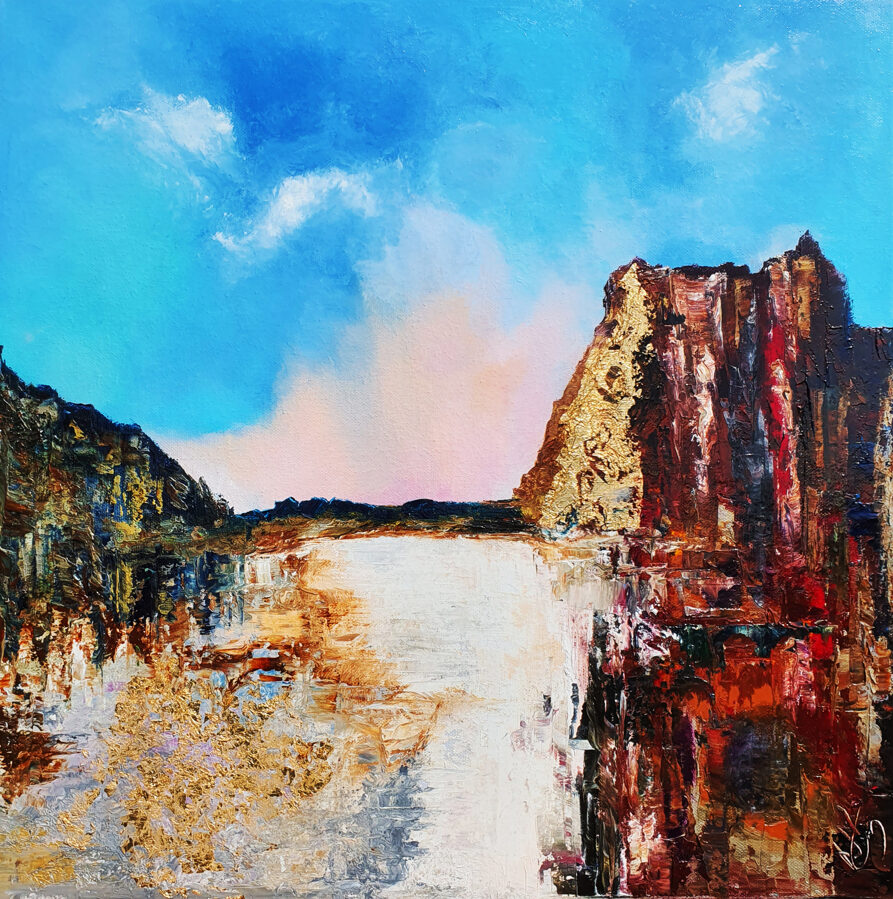
House of Romulus and Remus
- 65 x 50 cm
- Oil-gold-canvas
- Place and date of creation: Sitges, 2022
- Te artwork is part of 'Period of the Imperial Rome' collection
- The artwork is privately owned
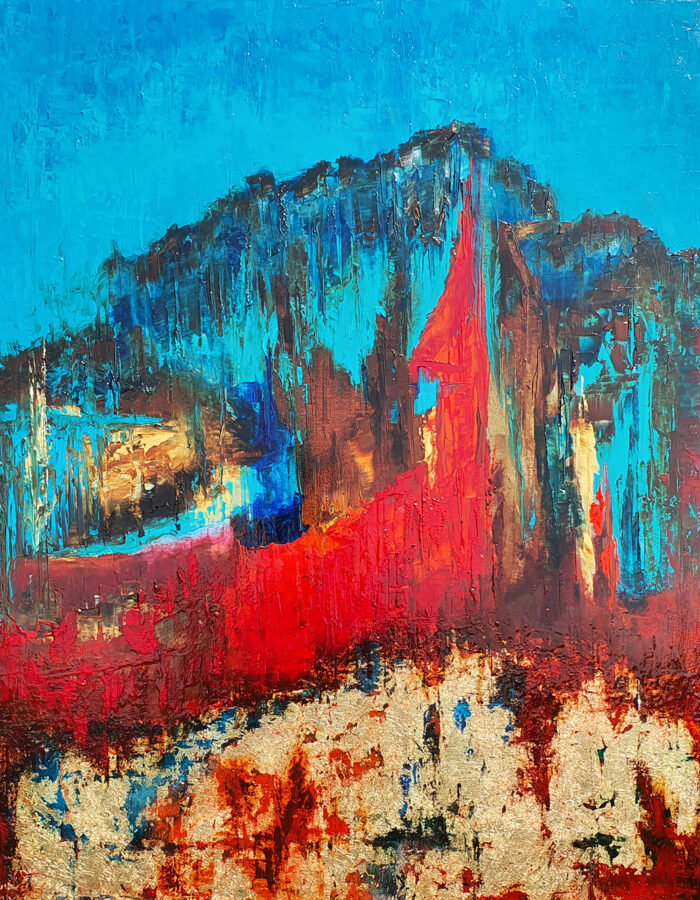
Story of Flora
- 60 x 60 cm
- Oil-gold-canvas
- Place and date of creation: Sitges, 2022
- Te artwork is part of 'Period of the Imperial Rome' collection
- The artwork is privately owned
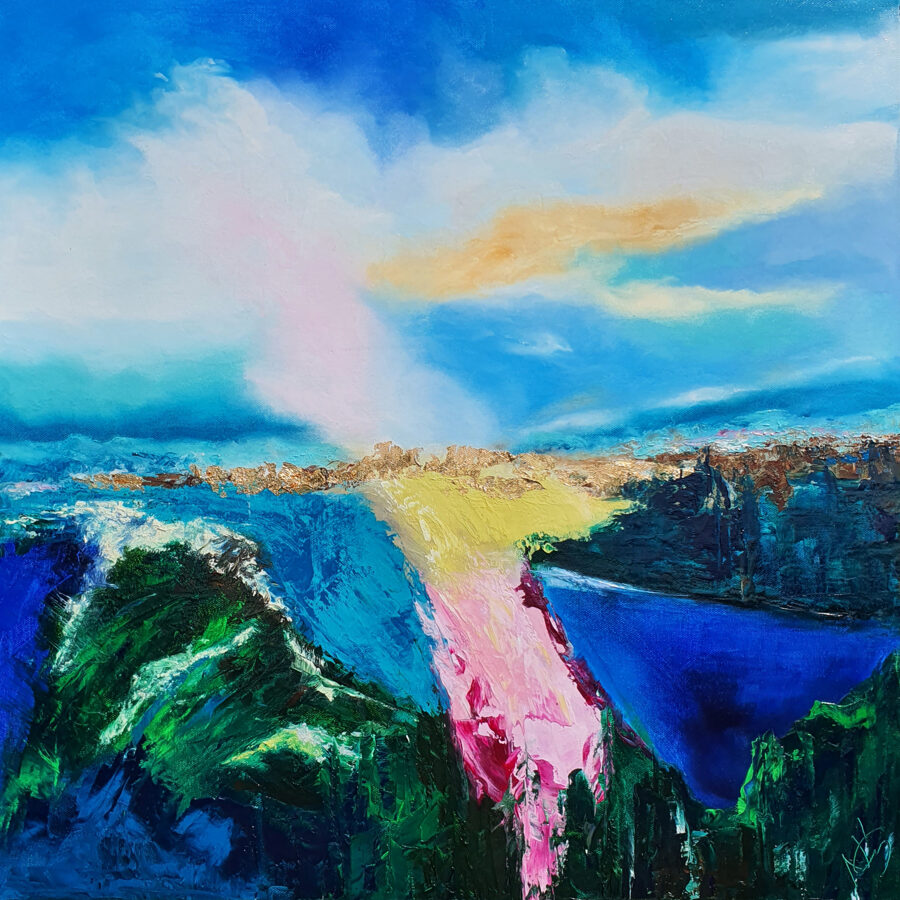
The Pun Fleet in Front of Lilybaeum
- 60 x 60 cm
- Oil-gold-canvas
- Place and date of creation: Sitges, 2022
- Te artwork is part of 'Period of the Imperial Rome' collection
- The artwork is privately owned

Cart
Cart is empty.

